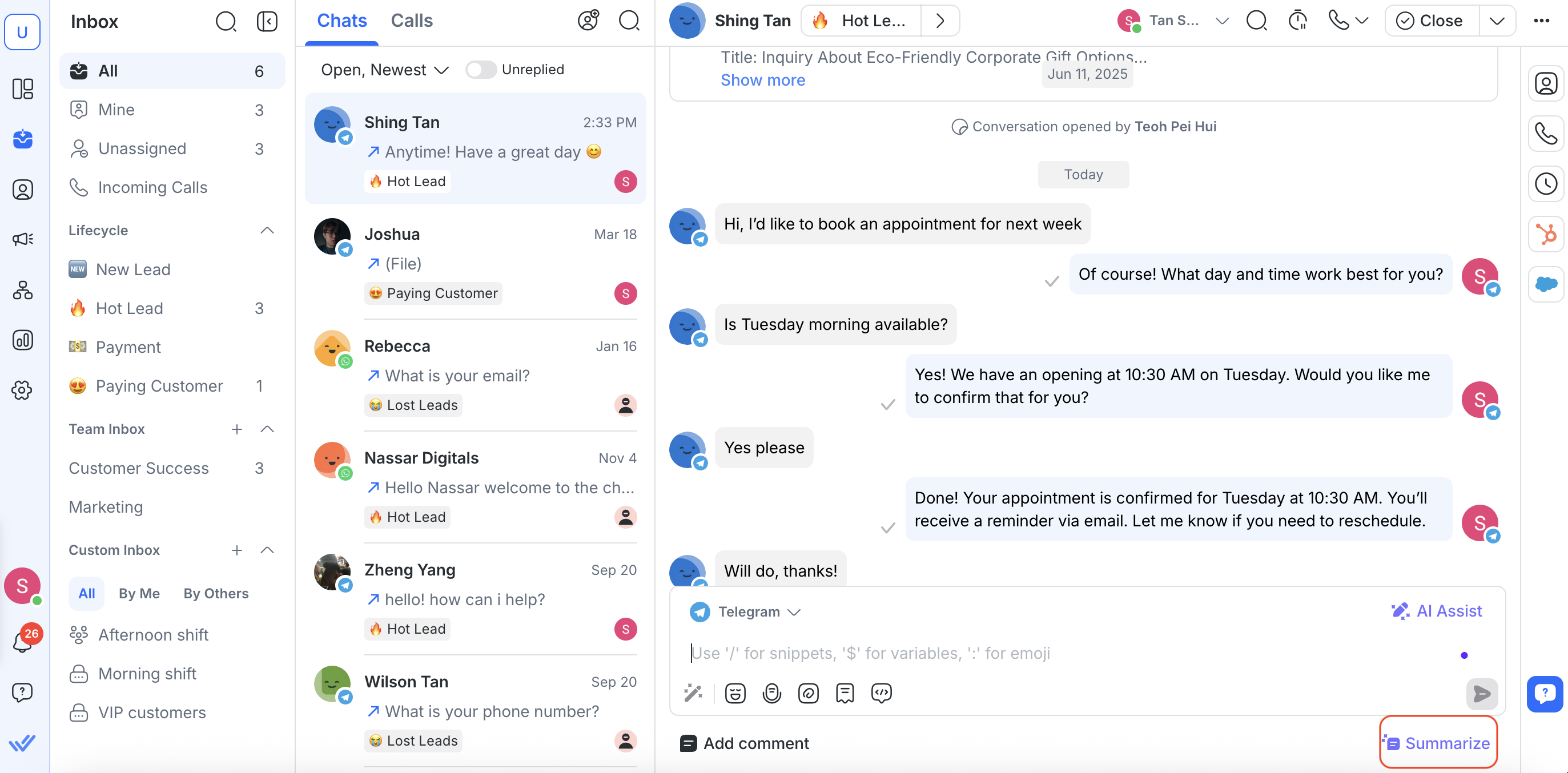Getting Here
This module can be accessed from the side navigation menu under the menu item, Inbox.
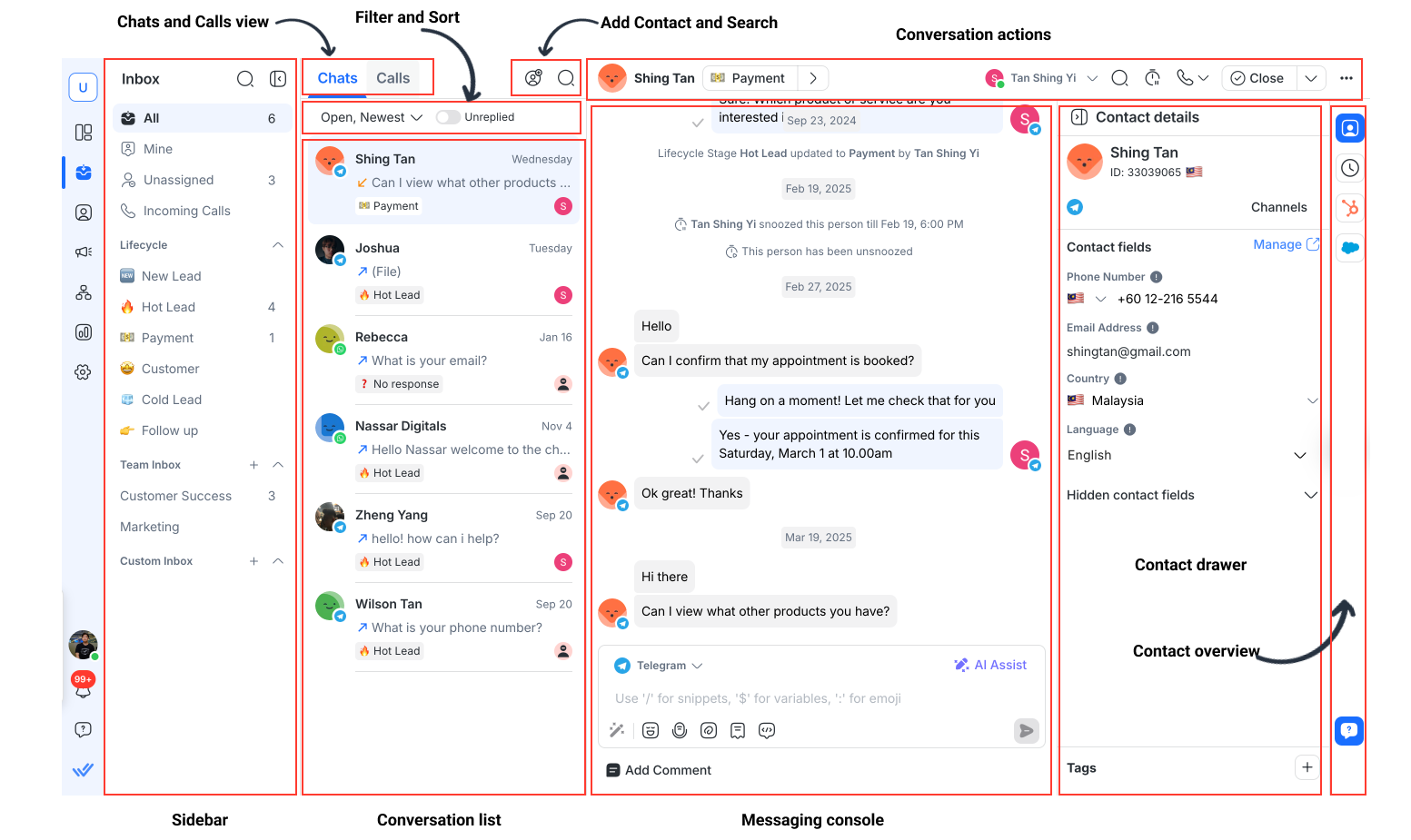
Sidebar
This is where you can search for an inbox or select your preferred inbox view.

There are 4 inboxes to choose from:
Standard inbox
There are 3 displays within the Standard inbox:
All: Shows all conversations on the platform.
Mine: Shows Contacts and conversations assigned to the User only.
Unassigned: Shows conversations that haven’t been assigned.
Agents with restricted Contact Visibility can only see the Mine inbox. Owners, Managers and Agents with unrestricted access are able to view all Standard inboxes.
Team inbox
This displays the inboxes of the various Teams in your Workspace, such as Sales, Marketing and Support.
Access to the Team inbox is granted as below:
Agents with the “View Contacts assigned to User only” restriction are not able to view any Team inbox.
Agents with unrestricted access or with the “View Contacts assigned to User’s team” restriction are able to view their own Team inbox.
Owners and Managers are able to view all Team inboxes.
Custom inbox
This section shows all the Custom Inboxes created by the User or shared by other Users. There are three sub-sections:
All: Shows all Custom Inboxes created and shared with the Users.
By me: Shows all Custom Inboxes created by the User.
By others: Shows all Custom Inboxes shared with the User.
Only the inbox creator can make changes to the settings. Learn how to create a Custom inbox here.
Learn about Custom inbox share settings here.
Blocked Contacts inbox
This displays the conversations of Contacts that have been blocked.
Access to this inbox is granted to Agents, Owners and Managers. This inbox will be displayed only if you have access to view conversations of blocked Contacts and there is at least 1 blocked Contact in the Workspace.
New Message Indicator
The blue dot indicator indicates a new incoming message in the relevant inbox. It disappears when the inbox is opened.
This feature only applies to Standard and Team inboxes.

The blue dot follows this priority order when marking new messages:
Mine > Team > Unassigned > All
If a new message appears in your Mine inbox, the blue dot will highlight it there only—it won’t appear in the Team or All inboxes. This behavior is consistent across the inboxes, following the same priority hierarchy.
Open Conversation Count
The Open Conversation Count indicates the number of open conversations in an inbox.
This feature only applies to Standard and Team inboxes.
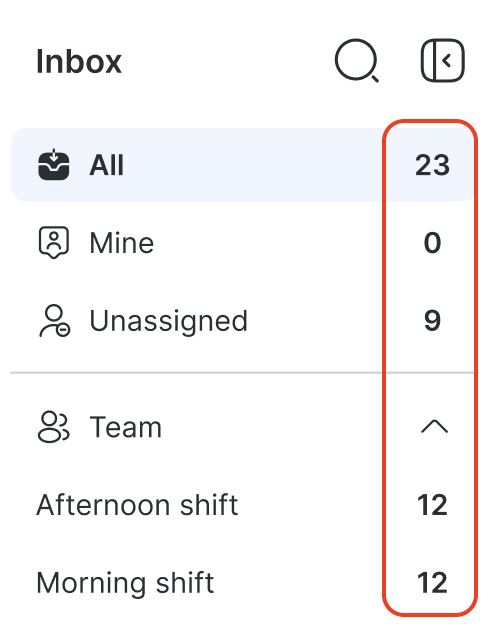
Incoming Calls

Agents with access to calling features will see an Incoming Calls tab in the Inbox sidebar. This menu helps agents stay organized and respond to calls efficiently, while respecting assigned permissions.
Visibility of Incoming calls
The visibility of incoming calls depends on the Contact Visibility restriction applied to the agent:
No restrictions: Agent can view all incoming calls, including those from unassigned Contacts or those assigned to other agents.
Restricted to team: Agent sees calls only from Contacts assigned to themselves or their team members.
Restricted to self: Agent only sees calls from Contacts assigned directly to them. Other tabs (e.g.
All) may be hidden.
The Incoming Calls menu includes three tabs (if permitted by the agent’s restriction level):
All: Shows all visible calls, including unassigned and those assigned to others (if unrestricted).
Assigned to me: Shows calls from Contacts assigned directly to the agent.
Unassigned: Shows calls from Contacts without an owner.
Each call entry displays the Contact’s name, Channel icon, assignment status, and—for WhatsApp calls—phone numbers (which may be masked if masking is enabled).
If there are no incoming calls for a specific tab, an empty state message will appear.
Ongoing calls
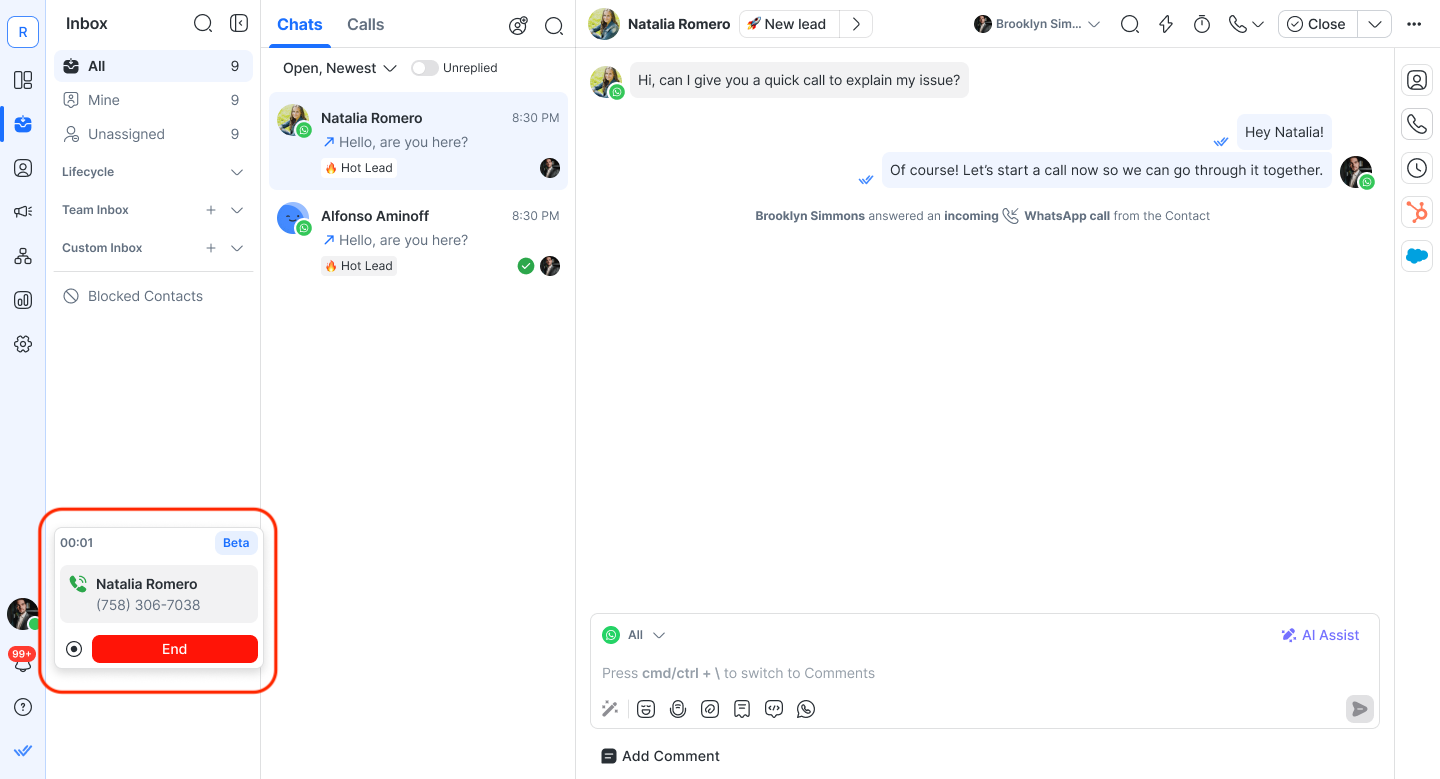
Once a call is active, the Inbox will display a call card showing key details of the ongoing conversation.
A call timer appears on the left, tracking call duration.
A Record button is available on the card, allowing agents to record the call if needed.
To end the call, click the End button.
Contact assignment on calls
When handling calls, Contact assignment is automatically managed:
If an agent answers an incoming call from an unassigned Contact, the contact is automatically assigned to the agent.
If an agent initiates an outgoing call to an unassigned Contact, the Contact is also automatically assigned to the agent.
AI call summary
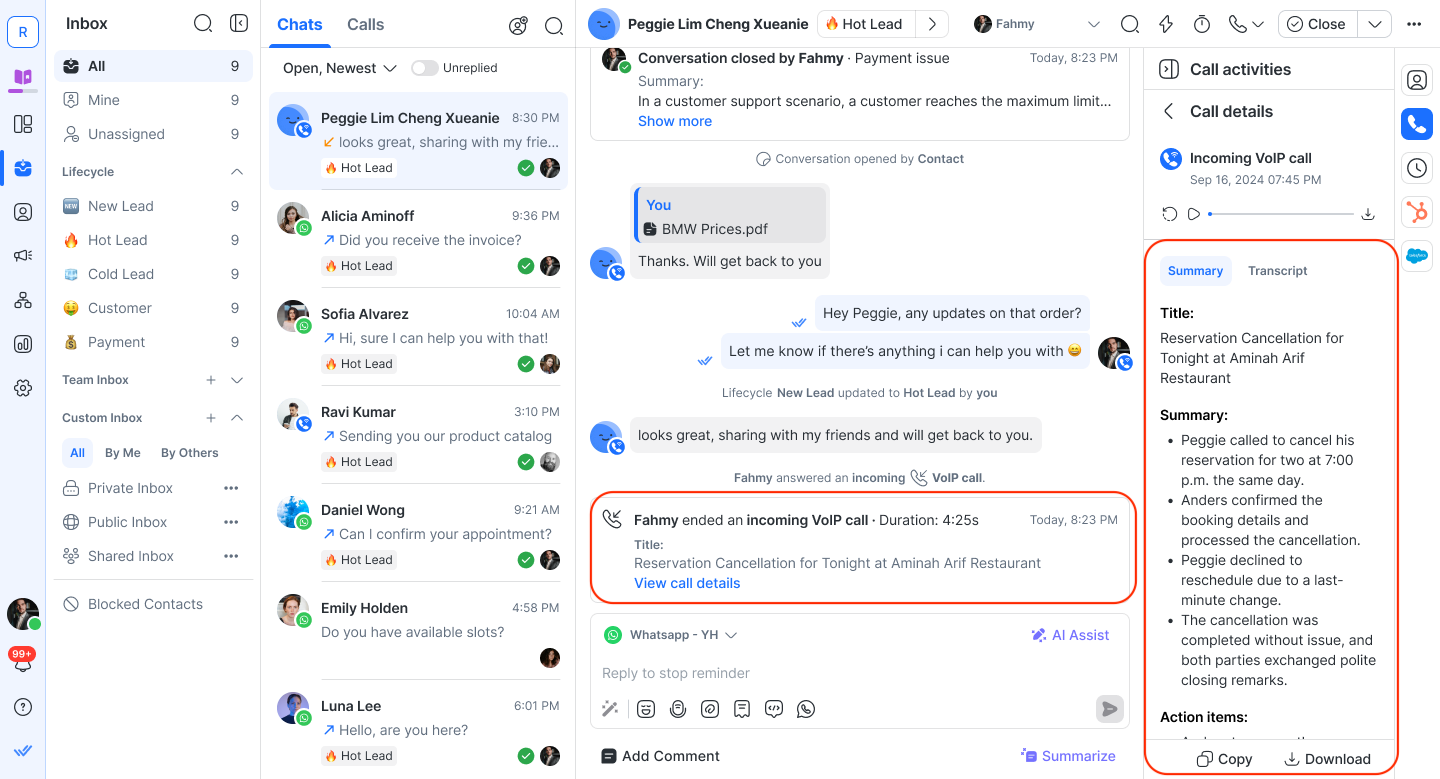
When enabled, an AI Call Summary is automatically generated after each recorded call ends. This provides a quick overview of the conversation without needing to replay the recording or read the full transcript.
The summary gives you:
A call title summarizing the main topic
A high-level summary of key points discussed
Action items with owners and next steps
You can also:
Copy the summary to your clipboard
Download it as a .txt file for external use
Note: AI Call Summary is only available when Call Recording is enabled. Learn how to enable it here.
Chats and Calls view
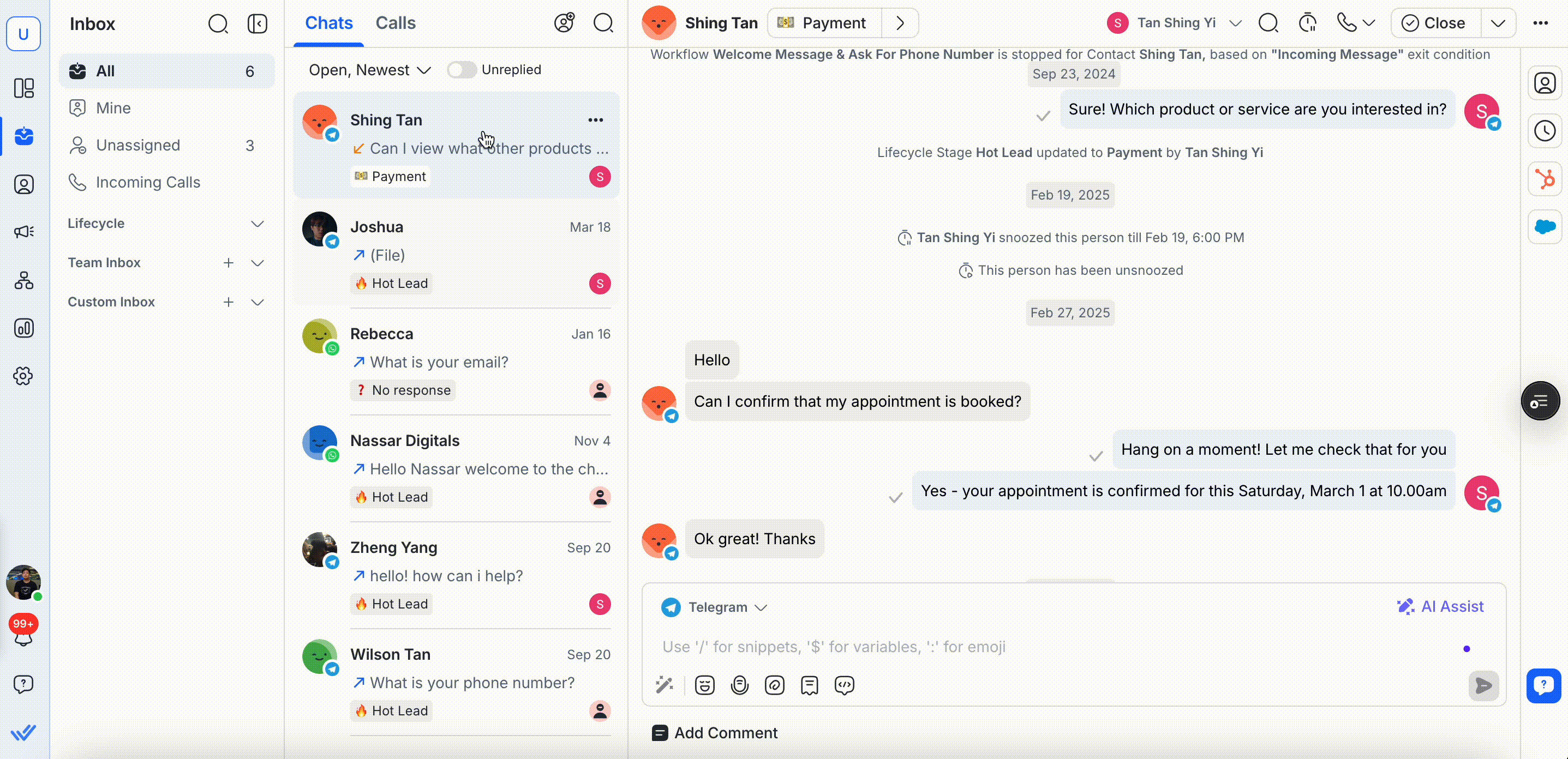
You can now switch between Chats and Calls using the tabs above the Conversation List.
Chats view shows your ongoing conversations.
Calls view displays call logs from your connected channels.
Use these tabs to quickly toggle between messaging and calling without leaving the Inbox.
Create new Contact and Search
Create new Contact
Click the Create new Contact icon to add a new Contact directly from the conversation list.
Fill in basic information such as name, phone number, and email.
You can assign the Contact to a specific team or inbox.
This shortcut helps you manually add new Contacts for outreach or record-keeping purposes.
Search for Contacts
Next to the Create new Contact button, click the search icon to search for Contacts, Messages and Comments.
To search for a particular Contact, click the Contacts button bellow the search bar.
You can only search for a Contact's first name, last name, phone number and email.
Partial or wildcard search: The search results include Contacts that are a partial match to the search query. Example: The search result for
carincludesCarlosandCarter, but notScarletandOscar. Here are the Contact details that are included in the search:First name
Last name
Phone number
Email
Strict-searching: Only Contacts that are an exact match of the search query will be included in the search result.
Custom fields, except for checkbox type, date type and time type.
Contact fields that cannot be searched:
Country
Language
Gender
Assignee
Conversation Status
Checkbox type (custom field)
Date type (custom field)
Time type (custom field)
Tags
For unsearchable contact fields, use filters to find the desired Contacts.
Search for Messages or Comments from All Contact Conversations
To search for a Message or Comment, click the Messages or Comments button, under the search bar. The search automatically begins once 3 characters are provided in the search bar with the recent messages/comments listed first.
The messages in text format that can be searched, include WhatsApp Templates, quick replies, and story replies.
Basic match: Search for 1 keyword. Example: the search results for “fox” returns all the conversations with messages/comments with the word “fox” in them.
Exact match: Searching for exact words. Example: the search result for “quick brown” returns conversations with an exact match ("quick brown") in them. This helps narrow down your search to most relevant conversations.
Emoji: Search for any emoji. 1 emoji equals a single character, so the search starts after 3 emojis are entered.
Email address: When searching for email addresses, messages/comments that have the exact match, partial match, or domain-specific match are included in the search results. Example: the search for the domain “@gmail” returns all email addresses of the specified domain.
Numbers: When searching for numbers, messages/comments that have the exact match or multi-number match will be included in the search results. Example: the search result for “016 014”, includes “…your number start with 016…” and/or “…your number starts with 014…”.
Message/Comment search is not filtered based on inbox, sorting, or conversation status.
Search for Messages and Comments from a Single Contact’s Conversation
You can also search for a message or comment inside a Contact’s conversation. Select the Contact and click the search icon on top to open the search bar. Enter the keyword that you want to search.

You can use the arrows or the search results dropdown to navigate through the search results in the Contact’s conversation.
Search Behavior
Your recent searches are listed in the same dropdown.
You cannot search for Broadcasted messages.
The search results are not case sensitive. For example, the search result for
SAMANTHAincludessamantha,SAmaand SAM.
Filter and Sort
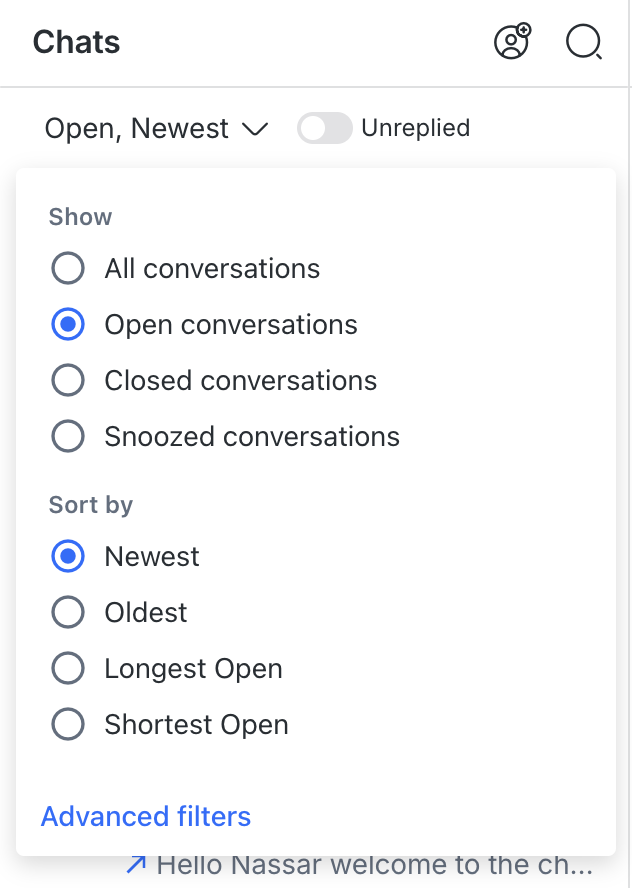
All status: Shows all conversations in the Conversation List of the selected inbox.
Open: Only shows conversations that are open in the Conversation List of the selected inbox.
Closed: Only shows conversations in the selected inbox that are closed.
Snoozed: Only shows conversations that are snoozed in the Conversation List of the selected inbox.
Unreplied: Shows only conversations that you or your team have not yet replied to. This is displayed as a toggle next to the filter dropdown.
A conversation is considered unreplied if its most recent message is an incoming message from the Contact. All other conversations are considered replied.
The sorting options are:
Newest: Sorts Contacts by newest messages to oldest messages. This sorting does not take broadcast messages into account. Where a Contact receives a broadcast message and it is the newest message, this will not move the conversation to the top of the list.
Oldest: Sorts Contacts by oldest messages to newest messages. This sorting does not take broadcast messages into account.
Longest (Open/Closed/Snoozed): Depending on which filter is chosen, conversations are sorted from the longest to the shortest conversation duration that were opened, closed or snoozed.
For conversations that have been unsnoozed, the conversation status time before the snooze occurred will be applied.
Contacts without conversation closed data will be displayed on top of the list.
Shortest (Open/Close/Snoozed): Depending on which filter is chosen, conversations are sorted from the shortest to the longest duration that were opened, closed or snoozed.
For conversations that have been unsnoozed, the conversation status time before the snooze occurred will be applied.
Contacts without conversation closed data will be displayed at the bottom of the list.
- The All Status filter option is not applicable to the Longest or Shortest sorting options.
- The filter option will be defaulted to All Status and disabled for Blocked Contacts inbox.
- Conversations for blocked Contacts will only be displayed in the Blocked Contacts inbox, regardless of the filter option selected.
In the same dropdown, there’s the advanced filters option. It helps you create tailored lists of Contacts. You can save these lists as Custom Inboxes for quick access.

Conversation List
The Conversation list shown is based on the selected inbox. Standard and Team inboxes refresh in real-time when the inbox is selected or a new message is received. Custom inboxes have to be manually refreshed by clicking the refresh button on the “Last updated X time ago” banner at the top of the list.
Selecting a Conversation
By default, the Conversation List is filtered by “All” and sorted by the newest messages first. Selected conversations are highlighted in blue.

Conversation Indicators
Indicator | Description |
|---|---|
Conversation Status | This label is displayed on the bottom left of each conversation in the Conversation List. It shows ‘Closed’ and ‘Snoozed’ statuses. No label is shown if the conversation is open. |
Channel | The channel icon is located at the bottom right of the Contact profile photo icon. |
Unread Count | If there are unread messages, there will be a count highlighted in a blue box besides the Contact's name. |
Last Message | The date on the top right of the Contact record shows the last message sent or received. The arrow indicates if the most recent message was outgoing or incoming. |
Assignee | The initial or User avatar on the bottom right indicates which User this contact is assigned to. |
If you need a find a specific Contact or conversation quickly, use the search bar at the top. Learn more here.
Quick actions
You can use quick actions to manage and organize conversations more efficiently.
With quick actions, you can:
Close a conversation
Open a conversation
Snooze ongoing conversations
Select predefined Shortcuts
Assign conversations to team members

Adding a Contact
Agents can add individual Contacts from the Inbox module. To add a new Contact, click on the Add new contact icon next to the search and filter bar.
Add in the contact details and select Save.

Messaging Console
This is where you can view, draft and compose messages to communicate with Contacts. When a Contact is selected from the Conversation List, their conversation history, inclusive of Message Metadata and Contact Events, will load here.
Message Metadata
Message metadata, including the sender, status, and timestamp, is displayed in a callout next to a message.
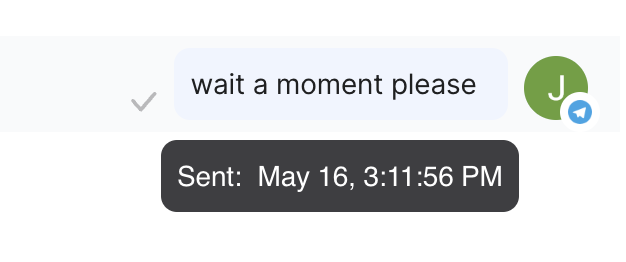
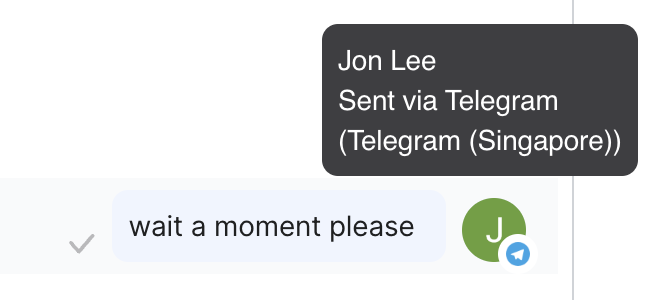
Refer to Message Status for more information on the different message statuses.
The message sender indicates how the message was sent.
Category | Sender |
|---|---|
Platform | Workflows |
Integration | Dialogflow |
Provider | Facebook InboxWhatsApp EchoFacebook Messenger Message Tag |
Human | User Name (Regular Outgoing Message) |
API | API |
Messages Action Menu
Use the messages action menu to reply to specific messages in a conversation, generate replies using AI and translate messages using AI. The reply action menu consists of 4 options:
Copy (to copy a message)
Copy link
Reply
Reply with AI Assist
Translate

Copy
Use the “Copy” option from the message actions menu to quickly copy the content of any message to your clipboard.
This is especially helpful when you need to:
Share message content with teammates in another channel or tool.
Reference a Contact’s message in notes or comments.
Quote part of a conversation in external documentation or follow-ups.
Simply click Copy, and the full text of the message will be available for pasting wherever needed.
Copy link
You can copy a direct link to any message in a conversation using the “Copy Link” option in the message actions menu.
This is useful when you want to:
Share a specific message with teammates for context.
Refer back to key messages during internal discussions or troubleshooting.
When someone clicks the link, they’ll be taken directly to the Contact’s conversation with the referenced message automatically highlighted, making it easy to locate in long threads.
Note: Message links are only accessible to respond.io users within your workspace. They won’t work for Contacts or external users.
Reply
When a Contact replies to one of your messages, the Inbox module will indicate the exact message they are referring to for context. It's important to note that the Reply-To Context feature is available for both incoming and outgoing messages.
Reply to incoming message
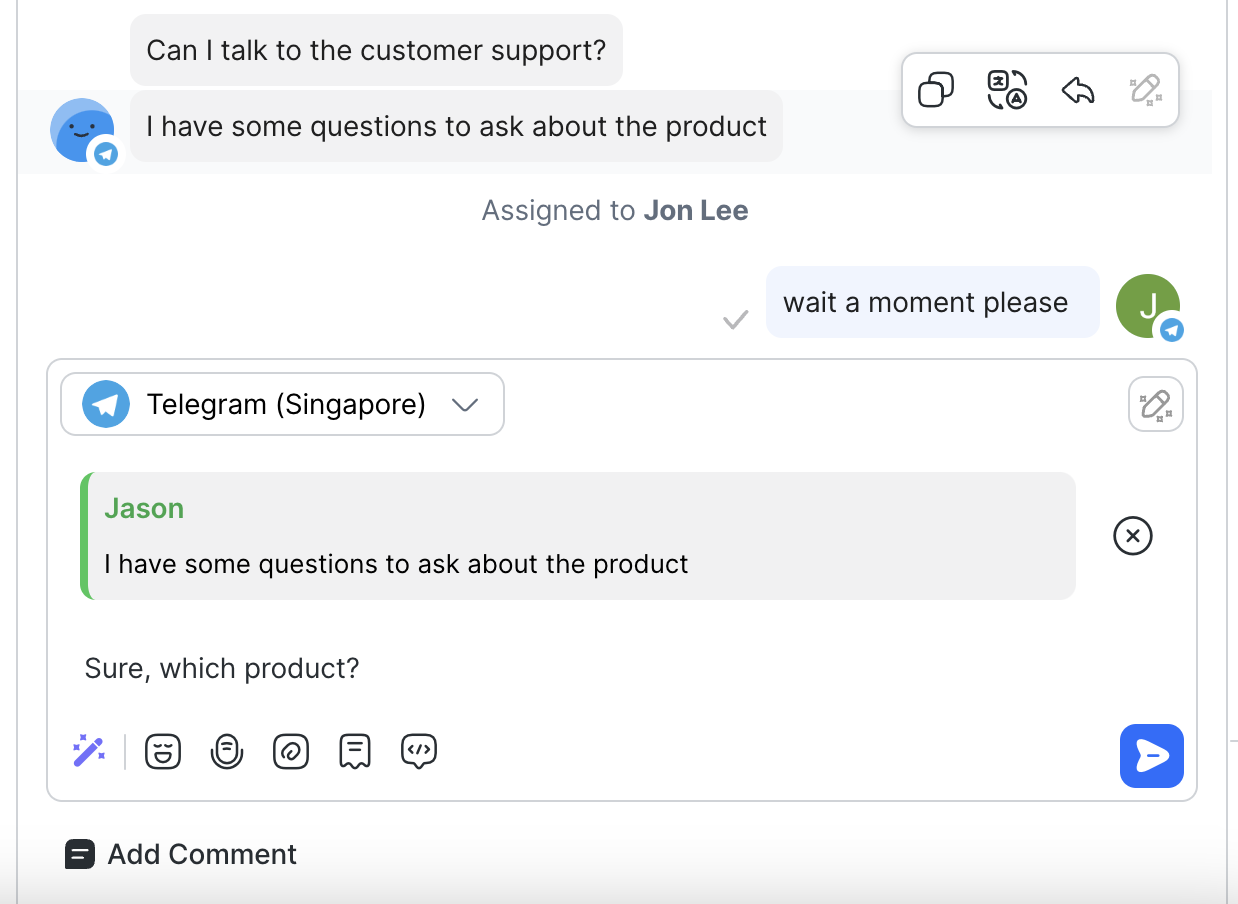
Reply tooutgoing message
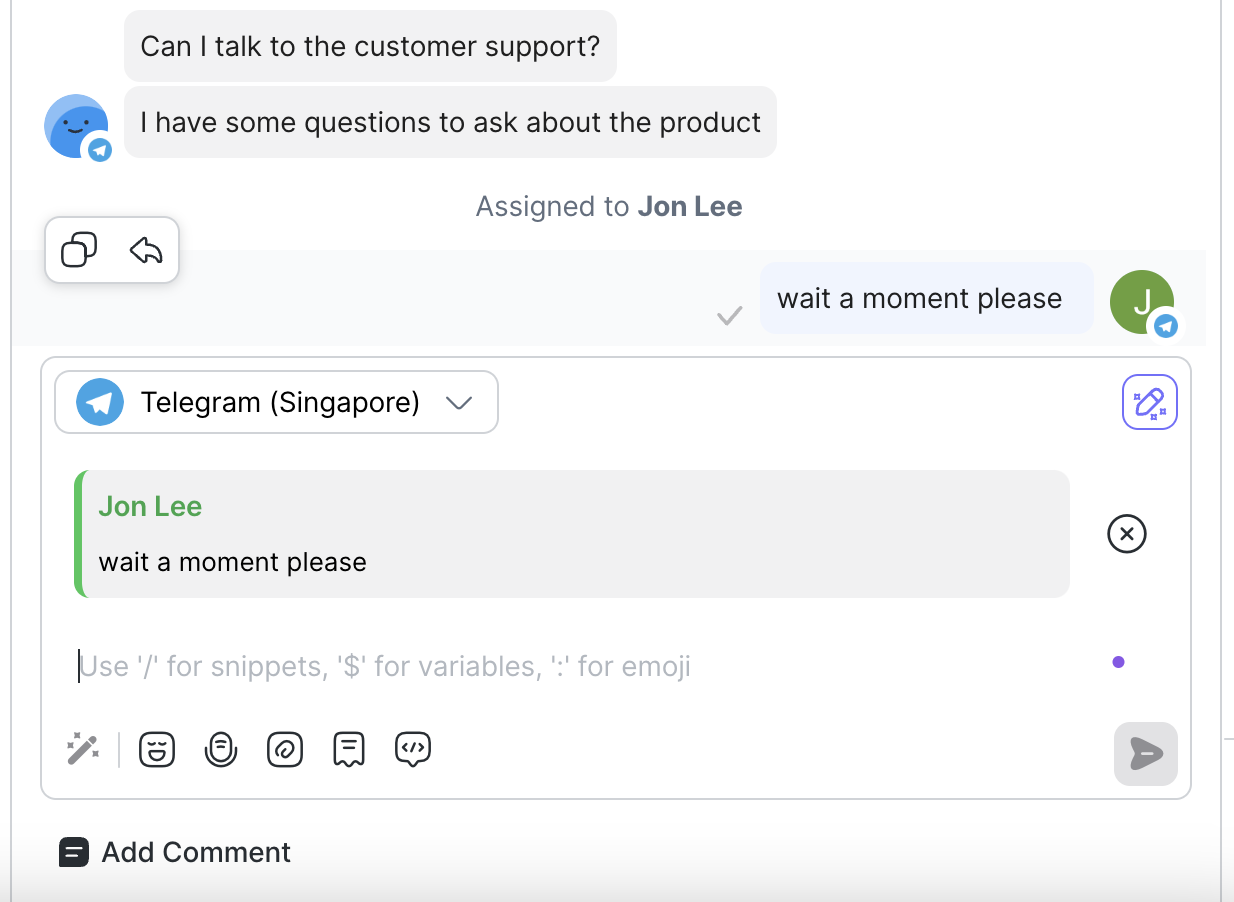
This feature is only available for selected Channels such as:
- WhatsApp Business Platform (API)
- WhatsApp Cloud API
- Telegram
Reply with AI Assist
In the reply action menu, select Reply with AI Assist to draft a response using AI Assist when replying to a specific message.

Translate with AI Prompts
You can translate messages and comments using AI Prompts in the messaging composer.

Email channels have different menu action items. These are the Reply and Show original email actions. Learn more
Message Status
When you send a message to a Contact, you can check its delivery status by hovering your mouse over the message.

For each message sent to the Contact, there will be an indicator that indicates the status of the message. The statuses are described as followed:

- Message Status is only applicable to messages sent within a Channel's messaging window.
- If a message fails to be sent to a Contact, hover over the message to view the error message from the platform or the Channel source.
Some messaging channels have limited coverage of message statuses. Refer to the overview page of the respective channel to learn more about the availability of message statuses for the channel.
Conversation Events
Message History will also keep track of important events, such as when a conversation was closed and by which source.

Event Category | Event |
|---|---|
Assignment | User Assigned |
Unassignment | User Unassigned by Close Conversation (Legacy) |
Conversation Closed | Conversation Closed (User) |
Conversation Opened | Conversation Opened (User) |
Snooze | User Snoozed the Contact |
Broadcasts | Broadcast Sent |
Workflows | Automation Workflow Started |
Bot Status Update | Bot Status Off |
Channel | Event coming from Channel |
Page Change | Event when a visitor navigates to a different page (Web Chat) |
Contact | Contact Merged |
Conversation Events with Reference
It is possible to trigger an event with a reference on supported Channels (Facebook, WhatsApp). References include tracking different links placed in different Channels or tying a Channel user to a session or account in an external app. A Conversation Opened or a Channel event can be triggered with a reference and the reference code will be stored with the event. For events that contain URLs as sources, the URL will also be stored and shown in the Inbox module.
Events will belong to a conversation if they are triggered during an open conversation.
Sending Messages
Refer to this quick guide on how to send messages to your Contacts.
Important:
- Some messaging channels have a limited messaging window. Be sure to plan your replies ahead of time to ensure your message is delivered. Refer to the overview page of the respective channel to learn more about the channel's messaging window.
- You cannot send any messages to Contacts that have been blocked. The messaging console will be disabled for blocked Contacts.
You can use AI Prompts to help enhance your messages before sending them to customers.
Use shortcuts in the messaging console to quickly access emojis, snippets and variables.
Receiving Messages
New messages will appear in the contact list of the Inbox module. New Contacts will be unassigned by default.
Typing Indicators
For Contacts: When a human agent or AI Agent begins typing, a typing indicator is shown to the Contact. This reassures them that a reply is on the way and encourages them to stay engaged in the conversation.
Supported Channels (for Contacts):
WhatsApp
TikTok Messaging
Telegram
For Users (agent-to-agent): Agents can also see when human agents or AI Agents are typing a reply to the same Contact. This feature is available across all channels, helping teams avoid duplicate responses and ensuring that effort is directed toward Contacts who still need attention.
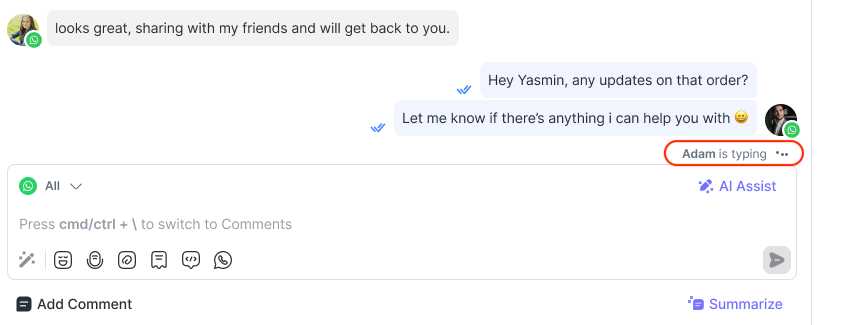
Link Previews
The Link Preview feature involves displaying link previews in messages, enabling users to remove these previews from the message console.
Link Previews are available for the following Channels: All WhatsApp Channels (except Vonage), Instagram, Telegram and LINE.
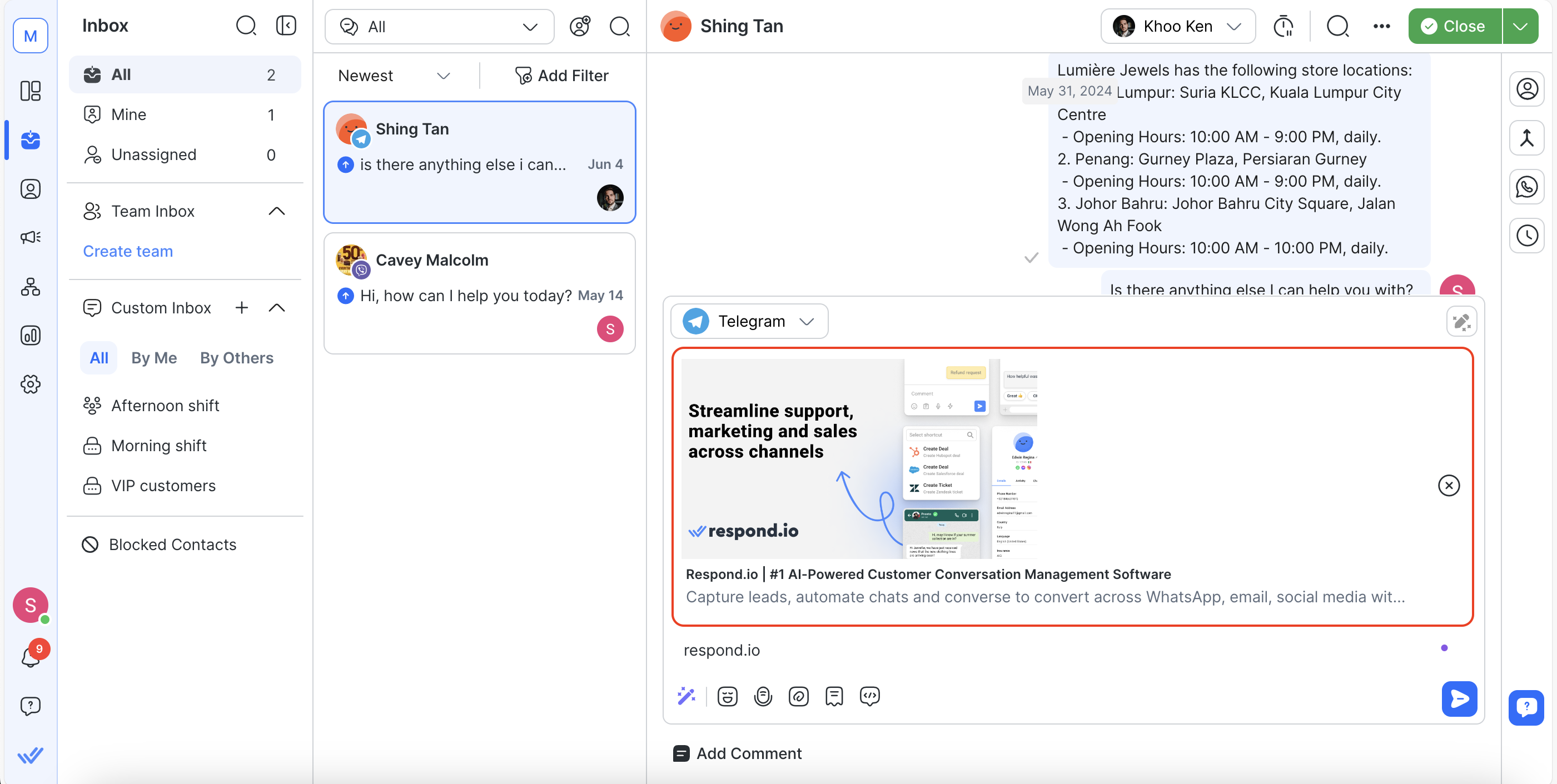
Link Preview Content
The Link Preview content includes image, title, description, and the website link associated with the URL.
Remove Link Preview in the Messaging Console
You can remove link previews from the messaging console when entering a URL. To remove a link preview, click on the "remove" button.

Link Preview Behavior
Incoming Message
Link previews will be displayed for incoming messages that contain URLs.
Outgoing Message
If you sent a message with a link preview, the Contact will receive the message along with the link preview, provided the Channel supports it.
If you have removed the link preview, it should not be displayed in the messaging console.
The Contact will receive the message without the preview if it was removed by the sender.
Only one link preview will be shown per message. When multiple URL links are present in a message, the preview of the first URL will be displayed.
Channel Switcher
Connect with Contacts across multiple Channels. Use the Channel switcher in the messaging console to switch between Channels to maintain your interactions with Contacts.
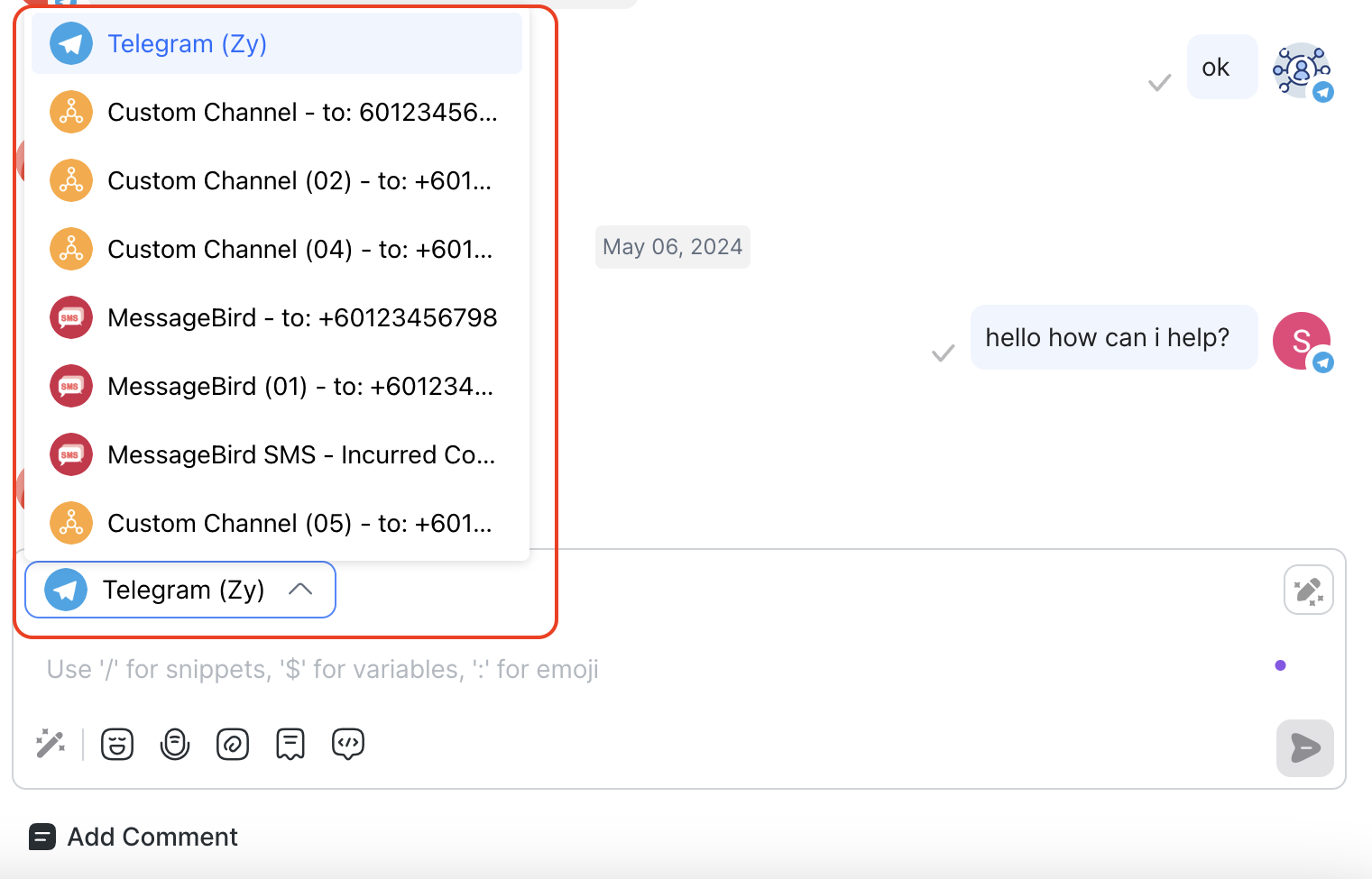
Unsupported Messages & Custom Payload
Messages that are not supported will have a fallback display with Unsupported Message or Custom Payload text and Type (if available). Click Show More to view the JSON payload of this message.
Examples of Unsupported Messages are:
Contacts
Ads Events
Line Flex Message
Instagram Profile
Instagram Avatar
Telegram Poll

Email Channel Composer
This composer only applies to emails and will not be shown if you switch to other channels.
For email channels, we provide additional functionalities in the message console to assist you in properly formatting and sending messages to your Contacts. These include:
Rich Text Editor: You can utilize the rich text editor in the messaging console to format your message by making text bold, underlining it, embedding links, adjusting alignment, changing color, and more.
Subject: In the message console, you can view the subject of each email you send via email channels. Additionally, when composing a new outgoing email in the messaging console, you have the ability to specify the subject. Please note that a subject is required for new outgoing emails, but you can receive and reply to emails from your contacts that do not contain a subject.
CC and BCC: Similar to regular email functionality, you can add additional email addresses to the CC and BCC fields when composing your outgoing email in the messaging console. Note that if the emails that are copied are contacts on the platform, it will not start a new conversation for them.
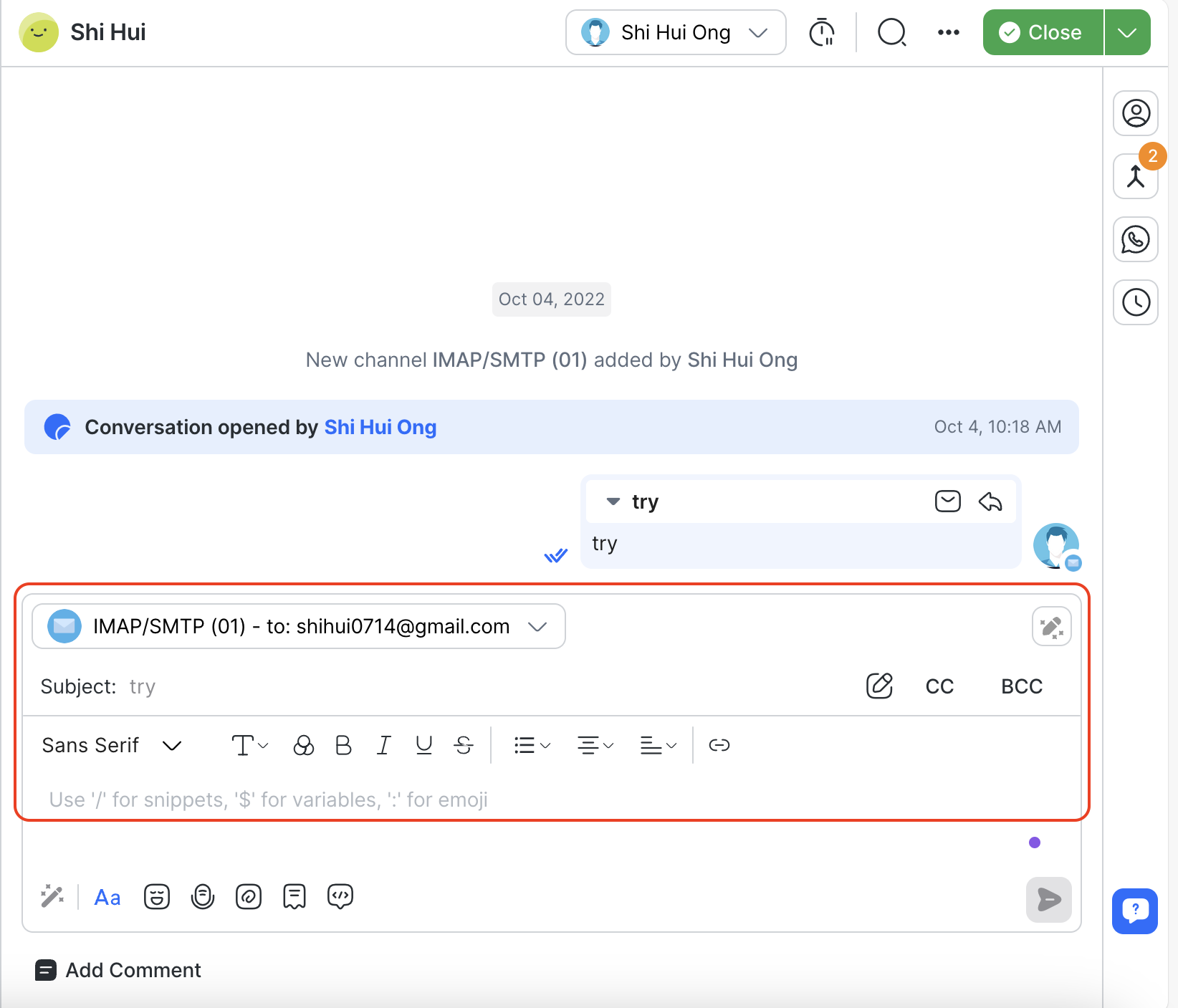
Reply: In addition, you have the ability to reply to specific emails that you have previously sent out. To do this, navigate to the specific message in the messaging console and click on the reply icon to initiate your reply to the email.

If you edit the subject of the message you are replying to, it becomes a new email.
Conversation History: Customers can see their conversation history when they click on the email open icon on the message called “Show email content”. Note that the history only shows for emails coming from your Contacts.
Adding Internal Comments
The Comments feature allows your team to collaborate seamlessly by exchanging internal notes directly within a conversation. Comments are visible only to workspace users and remain hidden from contacts. Use them to:
Share insights and observations
Request feedback from teammates
Leave instructions or notes before handing over a conversation
How to Add a Comment
Open a Conversation
Navigate to the contact you want to collaborate on and open their conversation in the Inbox Module.
Click “Add Comment”
This opens the internal comment composer, where you can start typing your note.

3. Mention Team Members
Type @ followed by their name to tag specific users in your comment.

Use AI to Summarize the Conversation
Instead of writing a summary manually, save time by letting AI do this for you.
Click the “Summarize” Button
You’ll see this in the comment composer toolbar. We use AI to scan the previous messages in the current conversation and generate a concise, bullet-point summary.
Using AI can summarize up to 100 messages from the latest open conversation.

2. Edit the Summary (Optional)
The summary will be appended to your comment. You can refine the content before posting it—especially useful for handovers or status updates.
Enhance Your Message with AI Prompts
Need help phrasing your comment? Click the AI Prompt icon in the comment composer to generate suggestions based on your intent.
This works similarly to the AI Prompts feature in the message composer and supports both default and custom prompts.
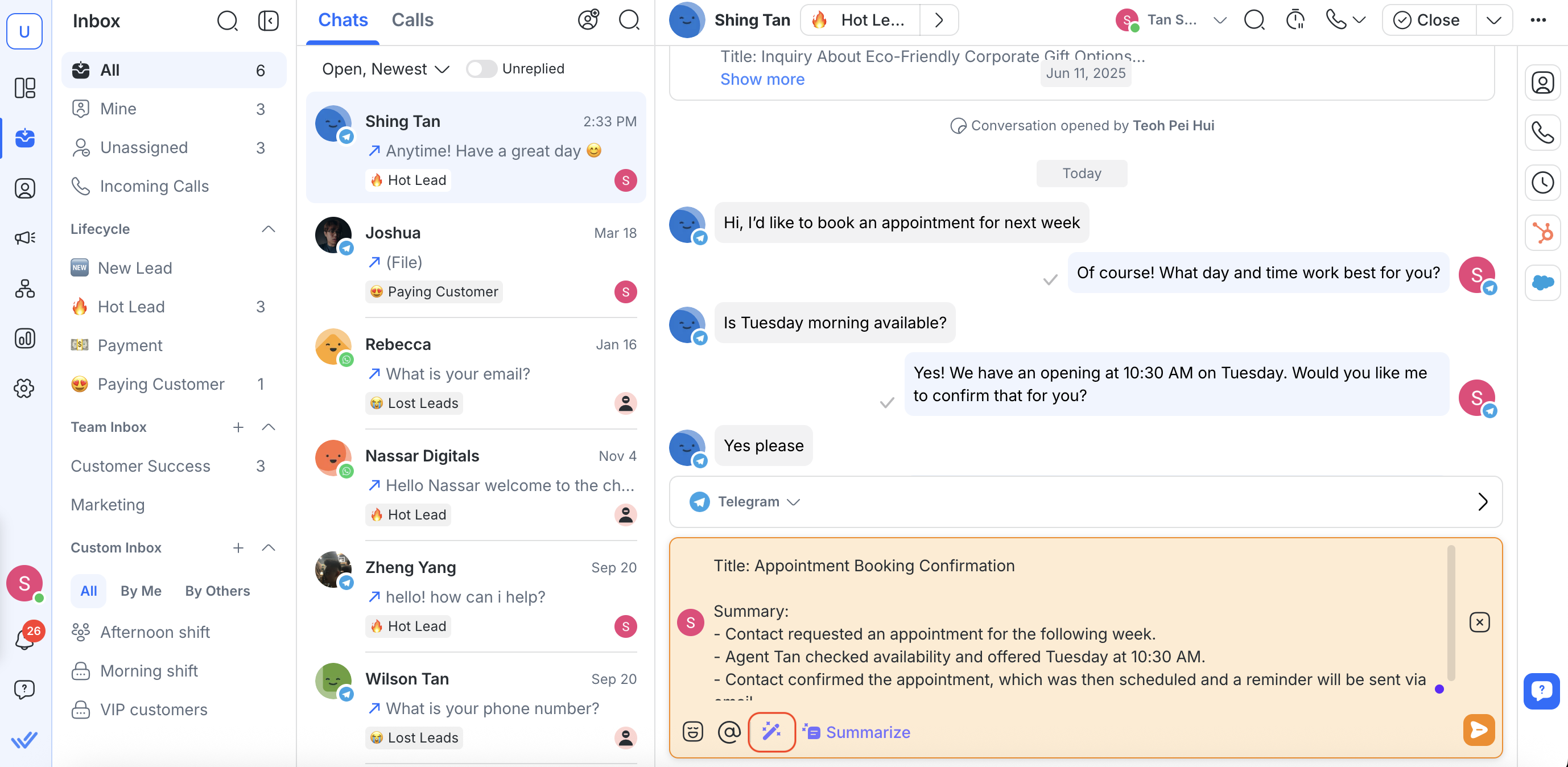
Conversation Actions
Contact Assignment and Closing a Conversation
Assigning a Contact and closing a conversation work in tandem to help your team stay organized when dealing with an influx of conversations. Assign Contacts to specific agents and archive resolved conversations by closing them.
Contact Assignment and Closing a Conversation are designed to work together to reduce the workload of the agent and manager. There are a few key actions that happen automatically to achieve this:
Anytime the platform receives a new message from a Contact with no open conversation, a new conversation will be opened for this Contact.
Any Agent who responds to an unassigned Contact will automatically assign the Contact to themselves.
The Agent will remain assigned to the Contact after the conversation is closed.
Refer here for more information.
Snoozing a Contact
A Contact can be snoozed to temporarily exclude them from the Contact List until a specified time, at which point they automatically reappear. This helps you set quick reminders for follow-ups.
Select the Contact in the Conversation List.
Select the Snooze icon or use the quick actions menu.
Choose a Snooze duration from the dropdown.
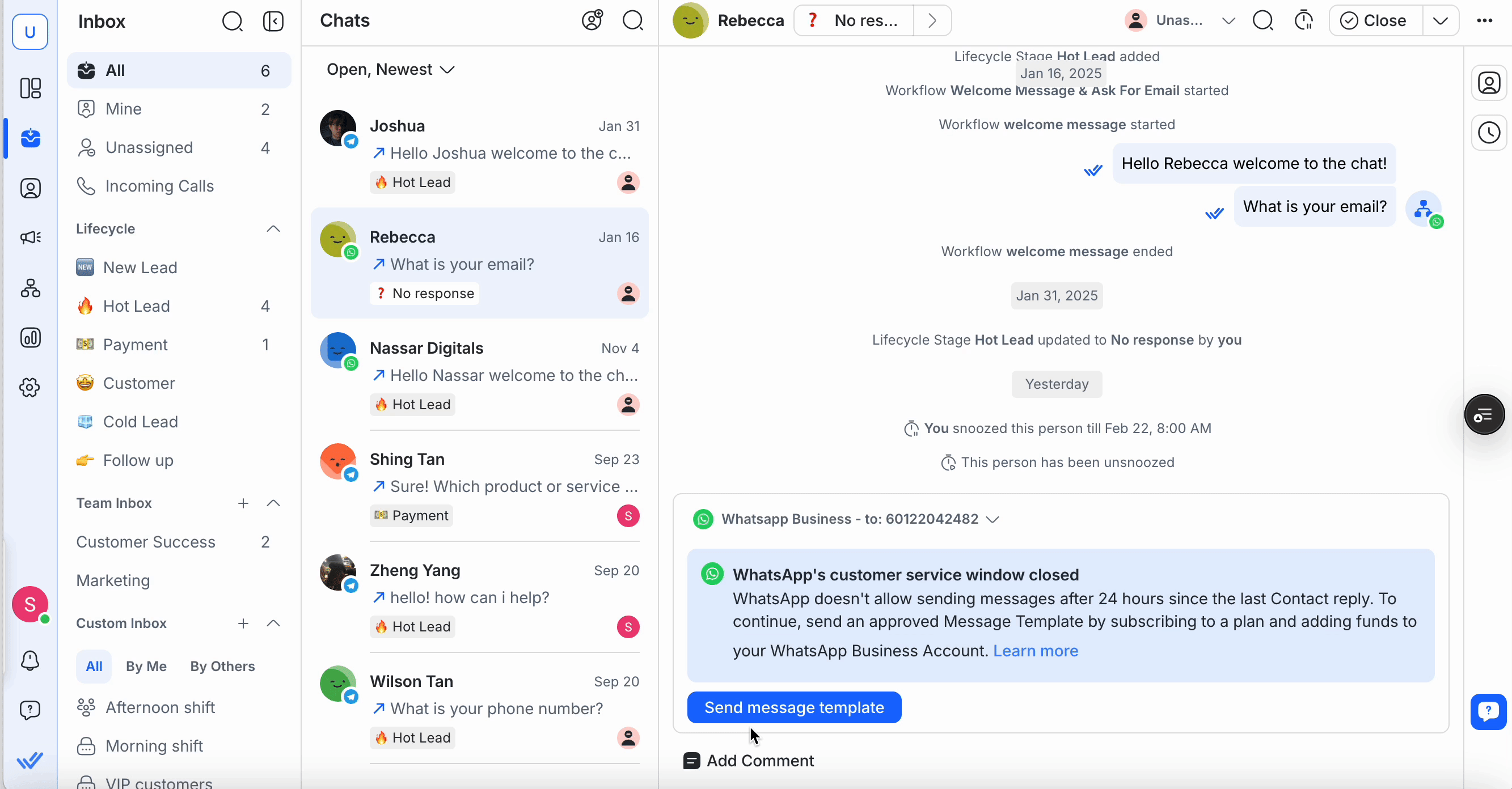
Once the selected Snooze time ends, the Contact will reappear in your conversation list with the status changed back to its previous state.
Whether a snoozed Contact is hidden or remains visible in the conversation list depends on the filter you are using:
Open or Closed: Snoozed Contacts will be temporarily hidden until the snooze time ends.
All or Snoozed: Snoozed Contacts will still appear.
You cannot snooze Contacts that have been blocked; the Snooze icon is unavailable in those cases.
When you snooze a Contact, they will not appear in the Mine list until the specified time.
You cannot snooze Contacts that have been blocked. The alarm icon will not be available for blocked Contacts.
Unsnoozing a Contact
To unsnooze a Contact early, click the Unsnooze icon or select “Unsnooze” from quick actions. The Contact immediately reappears in your Mine (or appropriate) list. Their conversation status reverts to what it was before snoozing.
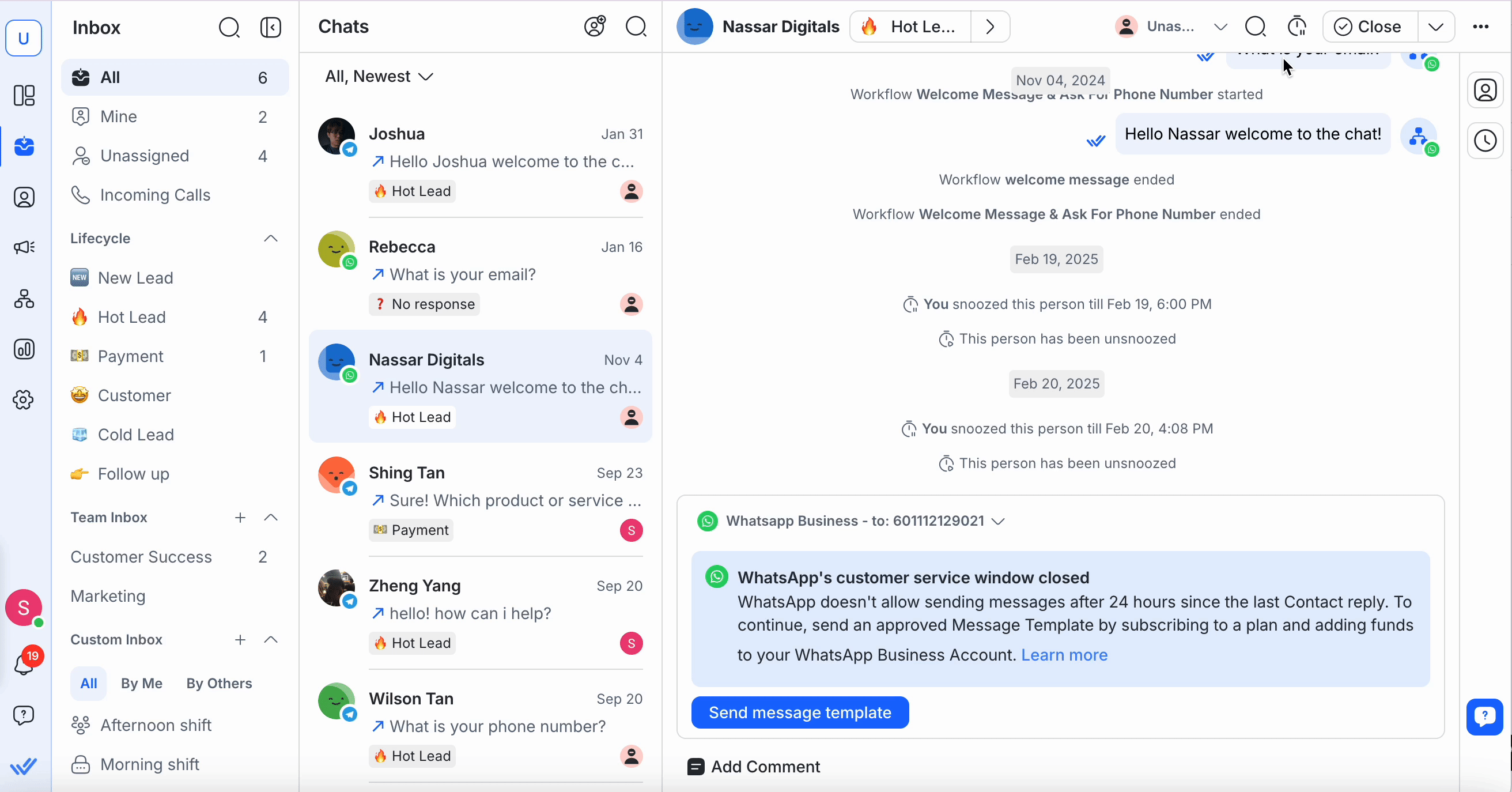
You will also be notified when the Contact is unsnoozed. Here’s how:
Reminder Line Item: When a Contact is snoozed, a line displays at the top of the messaging console. It disappears once the contact is unsnoozed.

Hover Callout: Hover over the Snooze icon to see the exact unsnooze timestamp.

Push Notification: When the Snooze ends, a push notification is sent to the assigned agent(s) according to the workspace notification settings.

Notification Center: A corresponding entry appears in the notification center with the ⏰ icon and text prompting you to open the conversation.
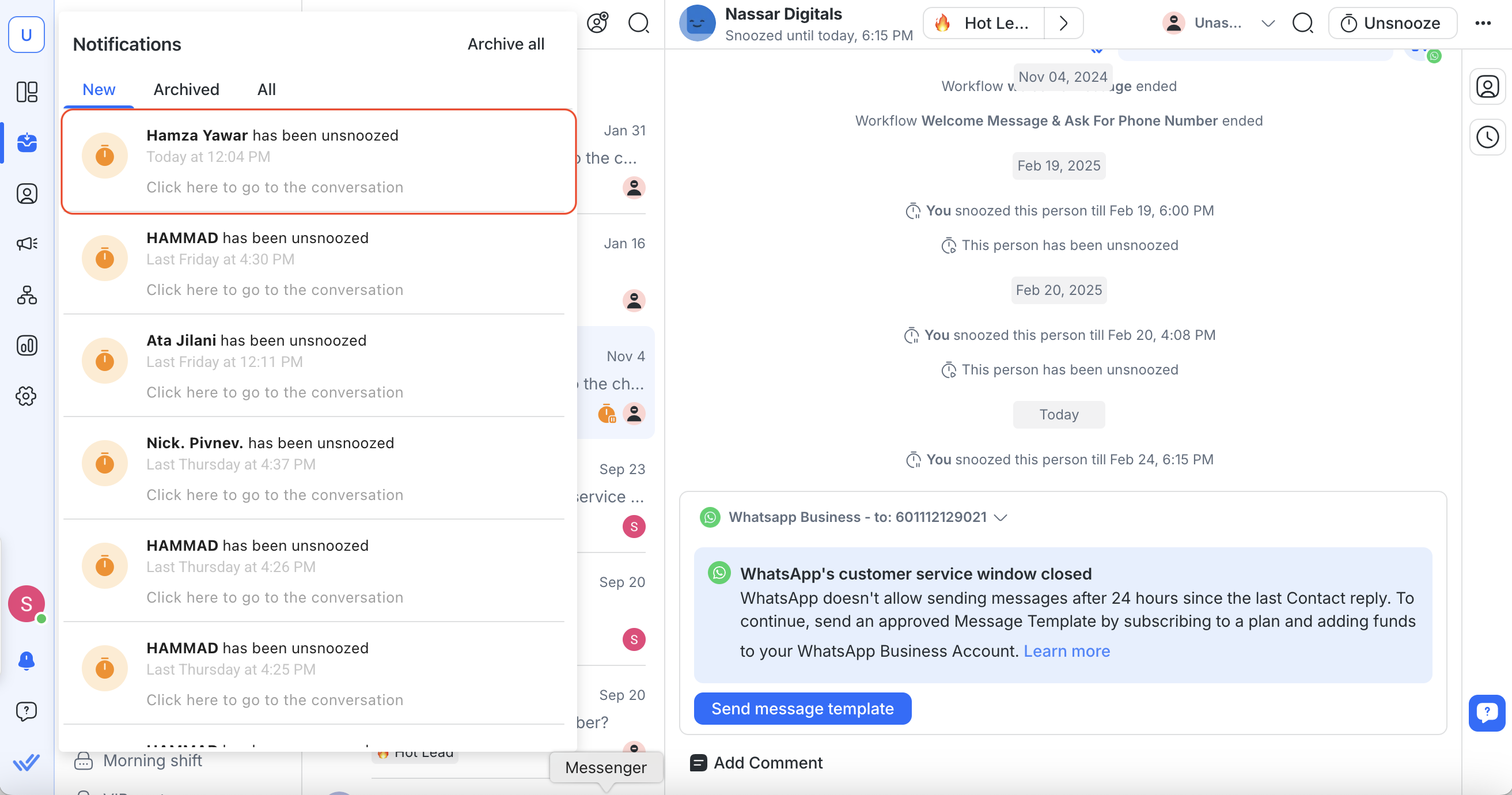
Blocking a Contact
If your Contact is sending you spam messages, you can block the Contact by clicking the action menu icon at the top right of the Inbox module > Block Contact > Block.

After blocking a Contact, you will no longer receive messages from them, nor will you be able to send messages to them.
Refer to this guide to learn more on how to block Contacts and understand the implications of blocking them.
Unblocking a Contact
If a Contact has been mistakenly blocked, you can reverse the action via the same action menu icon.

Once a blocked Contact is unblocked:
the conversation is moved back to the All or other inboxes depending on the conversation filters applied.
the conversation will remain closed.
the messaging console will be enabled and you may start sending and receiving messages from the Contact.
the Contact is moved to All or other Segments depending on the filters.
Shortcuts
Use the Shortcut icon to trigger workflows for a Contact.
View and search the available shortcuts for the Contact
You can trigger the shortcuts to start the Workflow for the Contact

Ongoing Workflows
View and select Workflows with the ongoing Workflows icon.
View and search the ongoing Workflows for the Contact
Choose and stop a Workflow for the Contact
Stop all workflows for the Contact

Vertical Sidebar
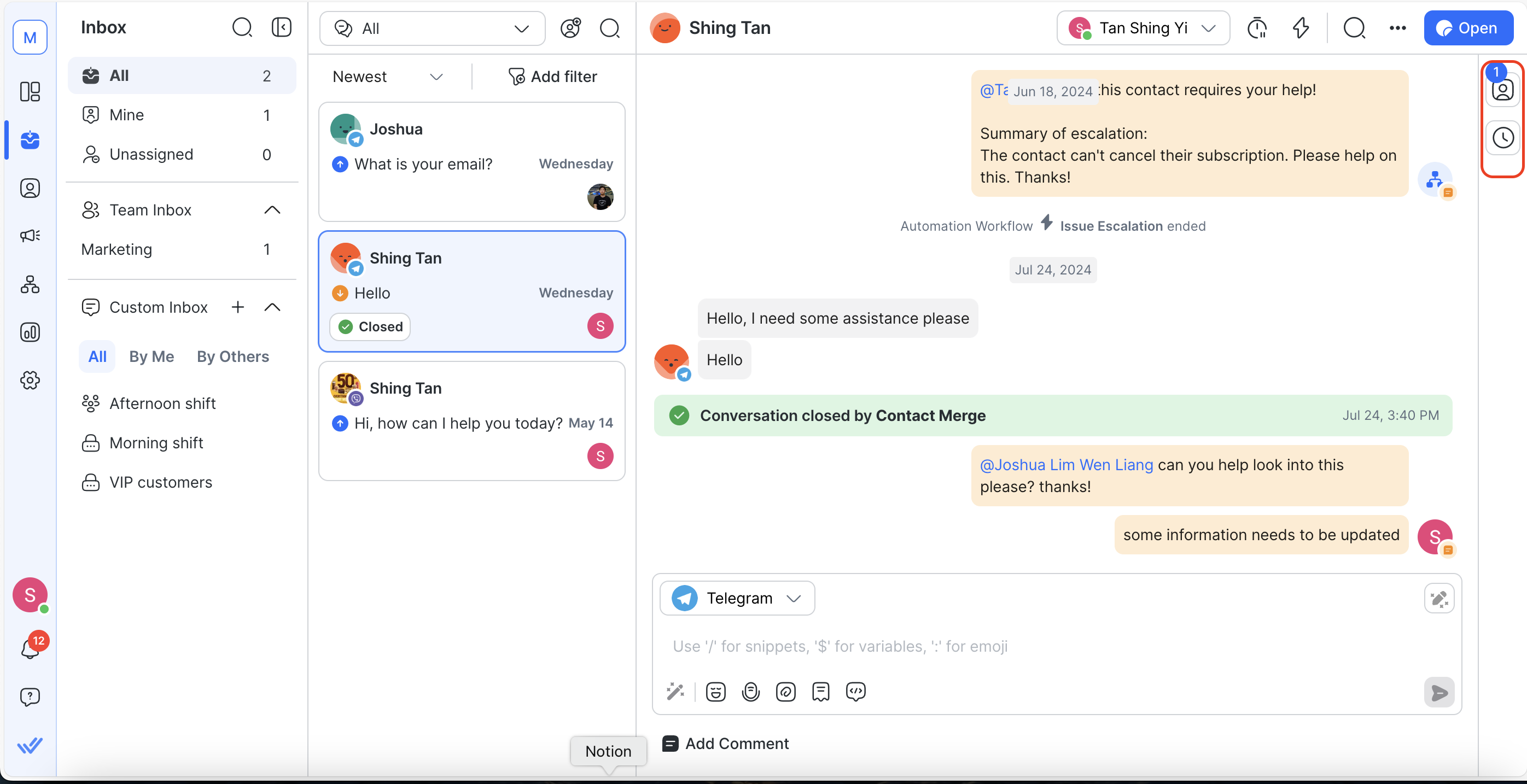
In the rightmost column of the Inbox module, you can access the Contact Drawer of a selected Contact by clicking on any tabs in the vertical sidebar.
The vertical sidebar has 2 tabs:
Contact Details
Activities
Call activities tab in Contact drawer
HubSpot properties
Salesforce fields
Contact Details
In this tab, you can access key information about the selected Contact such as their phone number, email, country and language. This information can be updated when necessary.
You can also view any merge suggestions if duplicate Contact information is found, along with the list of Channels connected to the Workspace.

Read more about Contact Detailshere.
Merge Suggestions
The merge suggestions card displays when potential duplicate Contacts are detected, listing all Contacts with the same phone number or email address as the selected Contact.
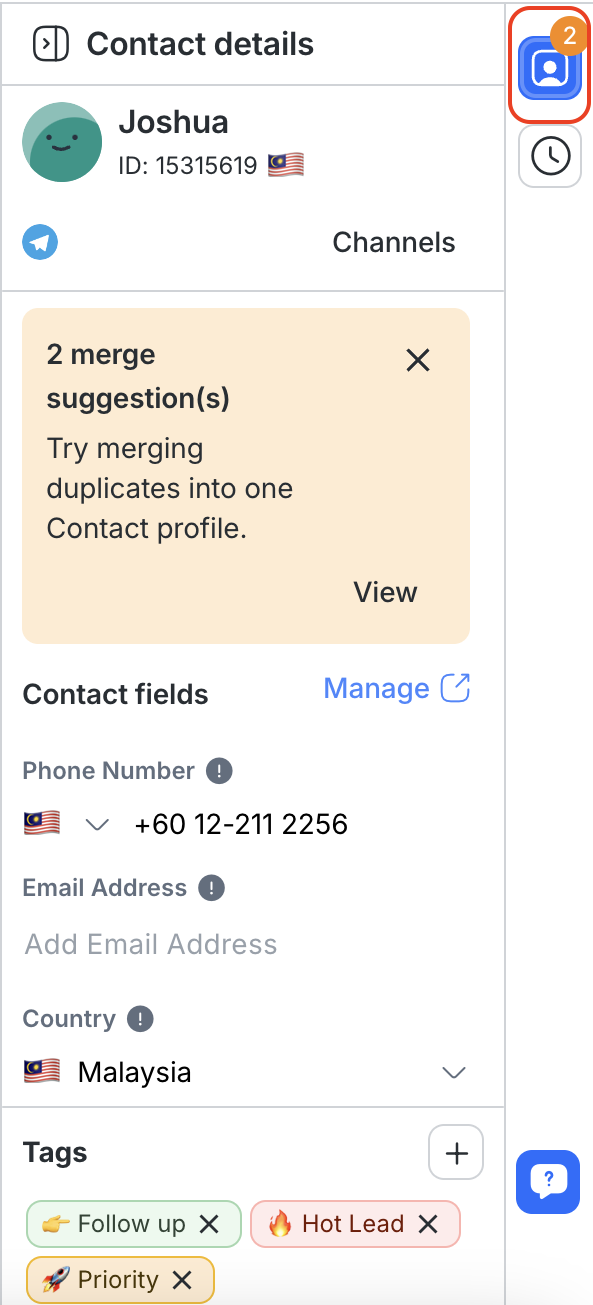
Read more about Merge Suggestionshere.
Channels
In this tab, you can find a list of channels connected to the Workspace with different indications.
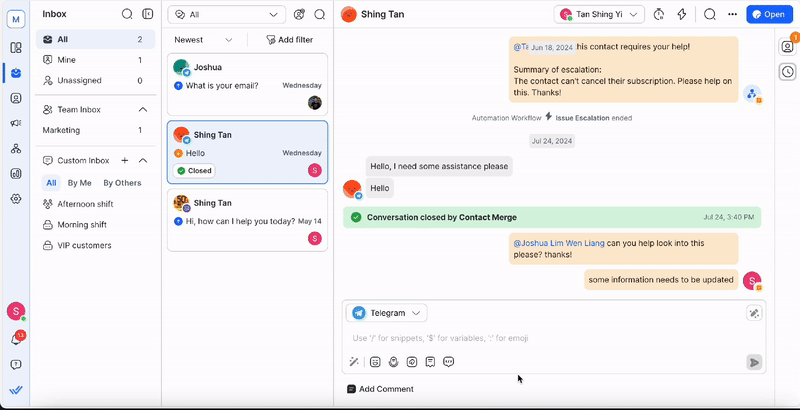
Read more about Channelshere.
Activities
In this tab, you can find all the internal comments and conversation events related to the selected Contact.
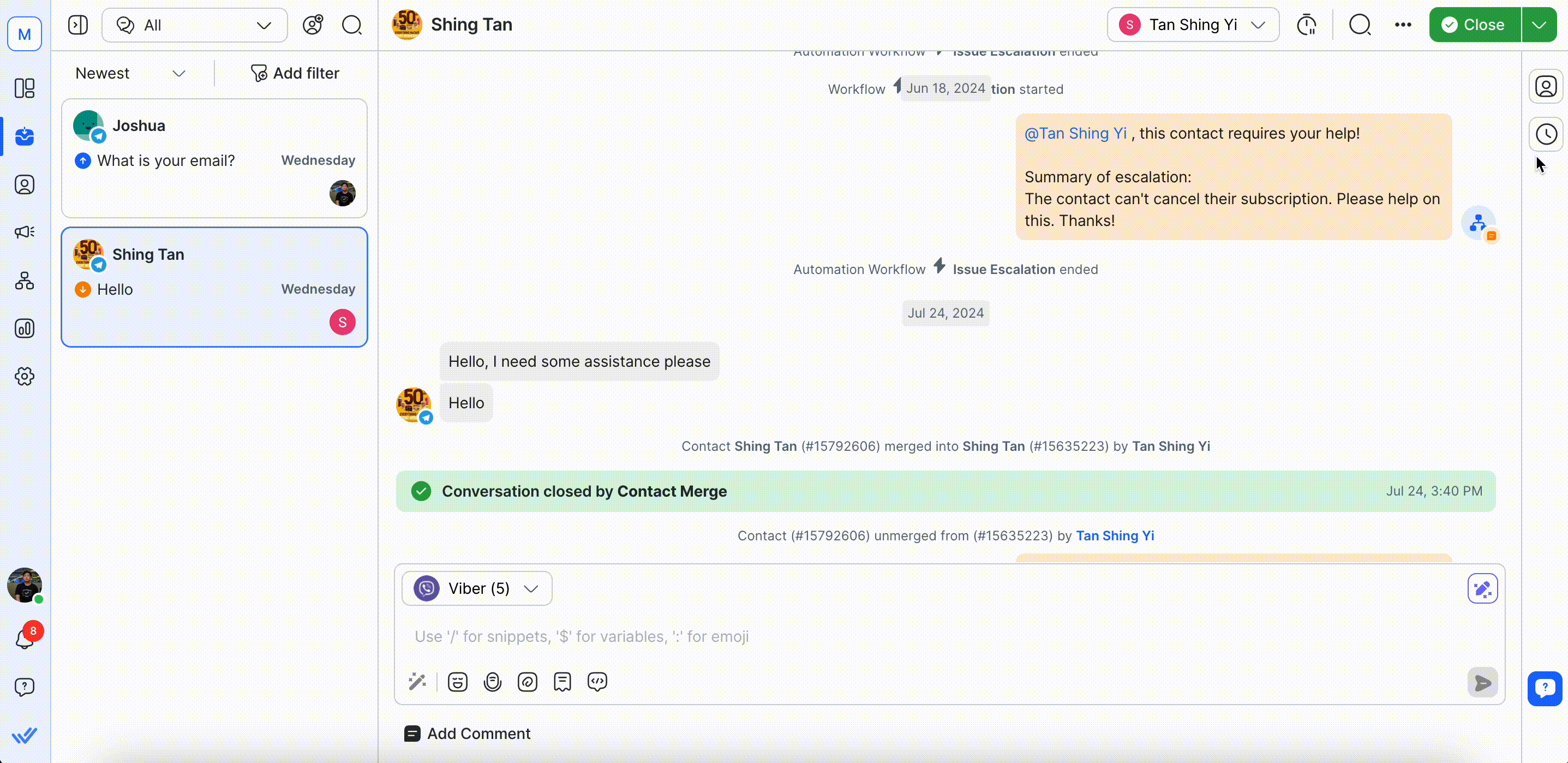
Read more about Activitieshere.
Call activities tab in Contact drawer
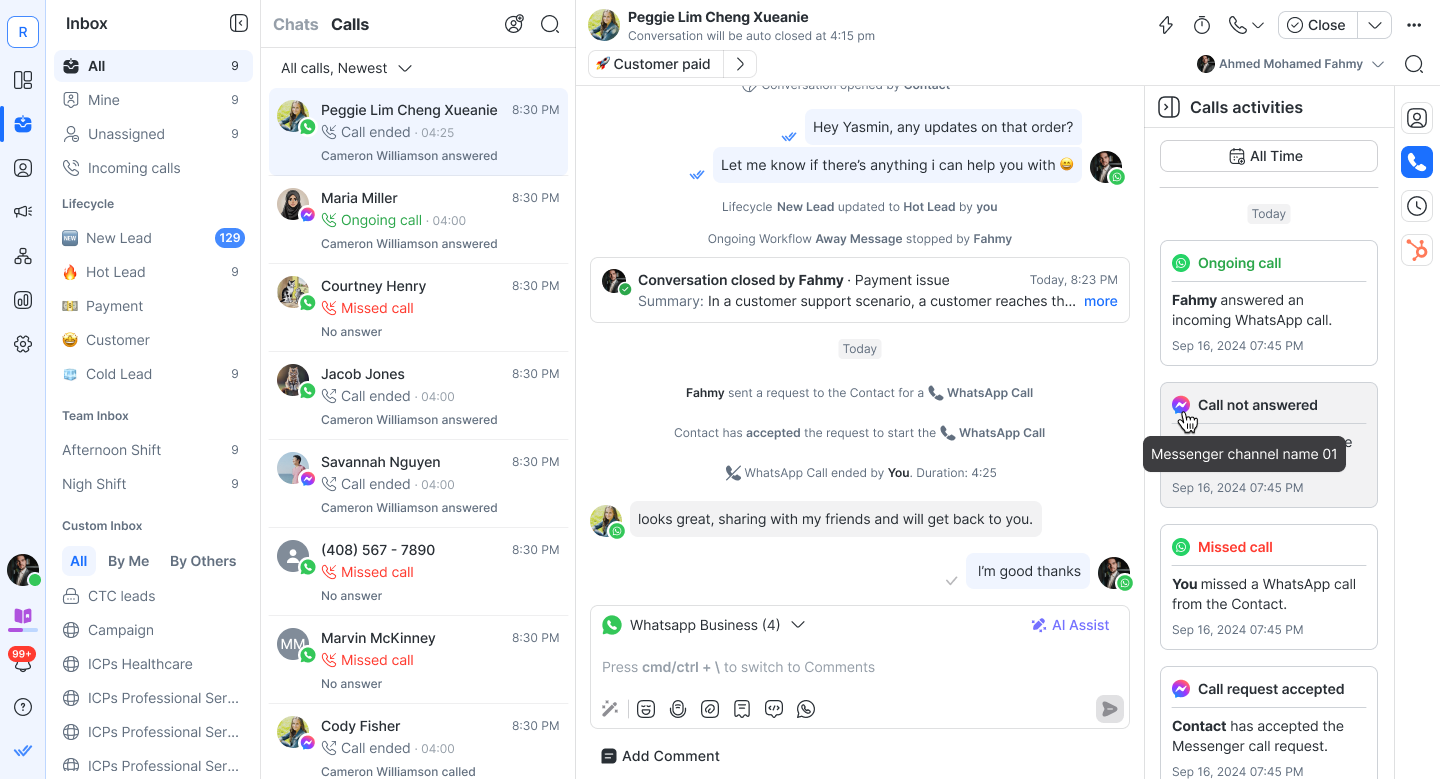
You can now access all call-related activities for a Contact in a dedicated Calls activities tab within the Contact drawer. This helps you easily view missed calls, ongoing calls, declined requests, and more, all in one place.
Clicking the icon toggles the tab open and closed.
Activities are grouped by date for easy browsing.
Viewing Call Activities
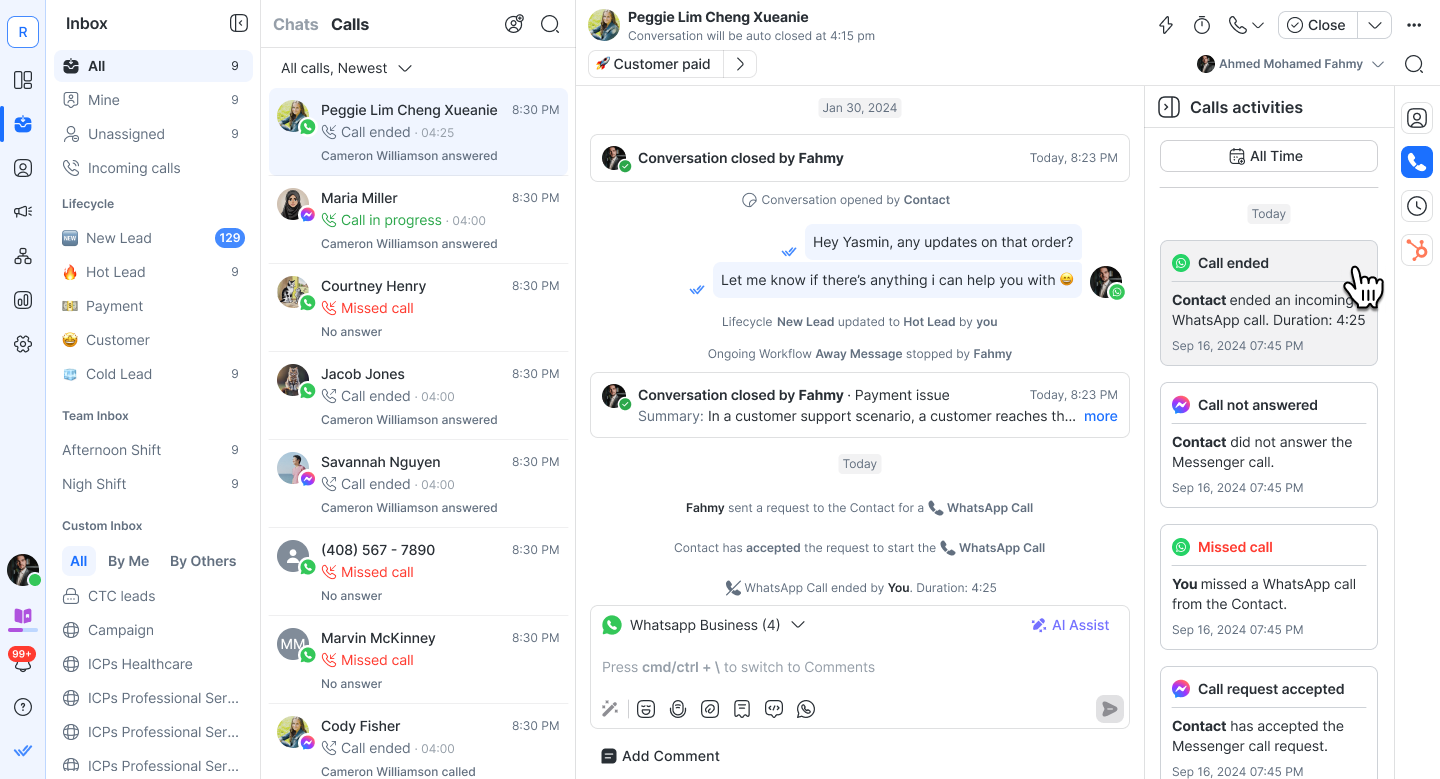
When a Contact has call-related history, a list of activity cards appears in the Calls tab. These activities are grouped by date (same as the existing Activities tab).
The following events are tracked:
Permission Request accepted / declined
Incoming & Outgoing Calls (Ongoing and Ended)
Missed Call / No Answer
Call Ended due to max duration
Call details
If enabled in Workspace settings, you’ll also have access to additional call details such as recordings and transcripts. These are displayed alongside call activities but come with their own dedicated controls.
Call Recordings

Playback directly within the call event card.
Download recordings for offline reference.
Call Transcripts
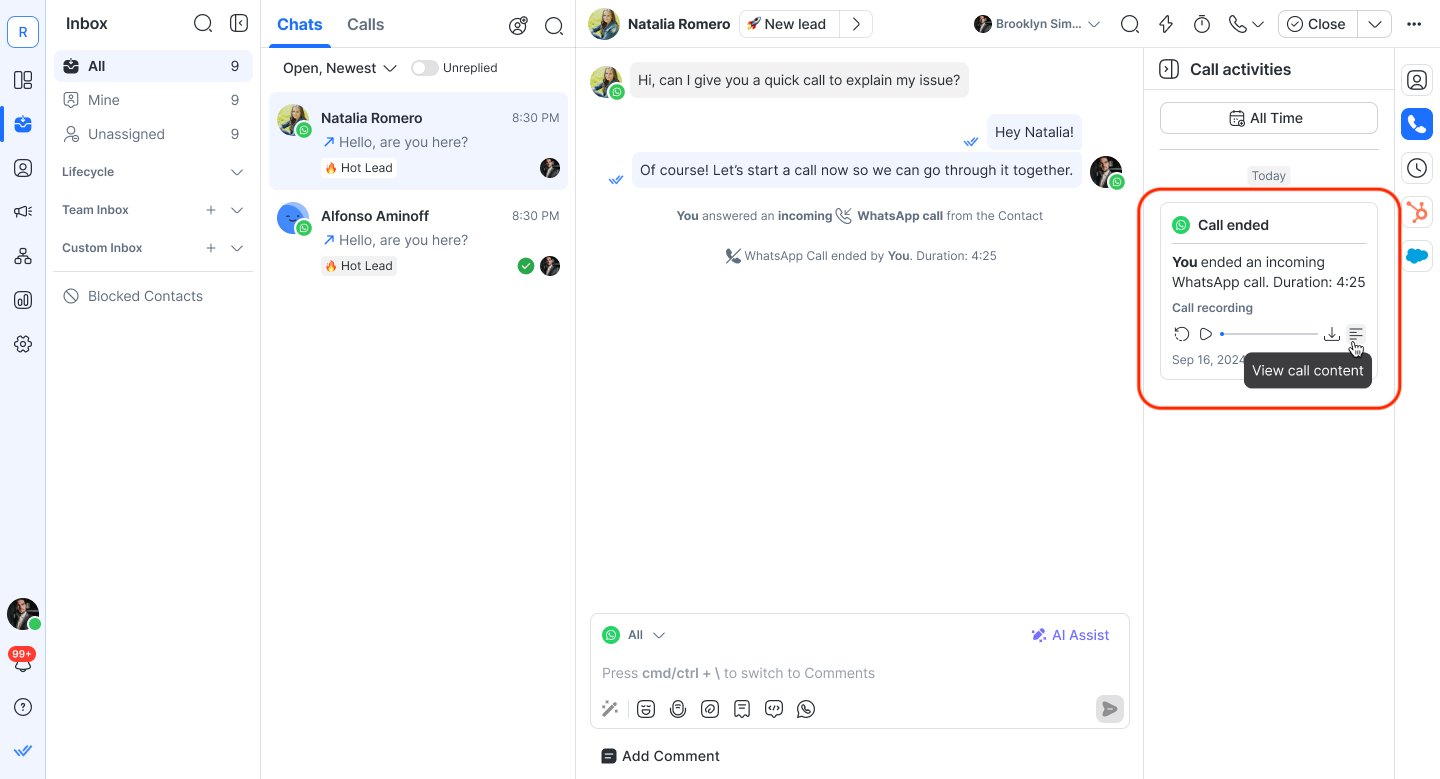
Transcripts are available only if Call Recording and Call Transcripts are enabled in Workspace settings.
View transcripts inline.
Copy text for easy reuse.
Download full transcripts for documentation or compliance.
Ongoing calls will always appear at the top of the list.
HubSpot and Salesforce integrations
If your Workspace is connected to HubSpot or Salesforce, you’ll see CRM information directly in the Contact Drawer. From here, users can view, manage, and edit supported fields—streamlining contact management without leaving the Inbox.
Accessing HubSpot properties:
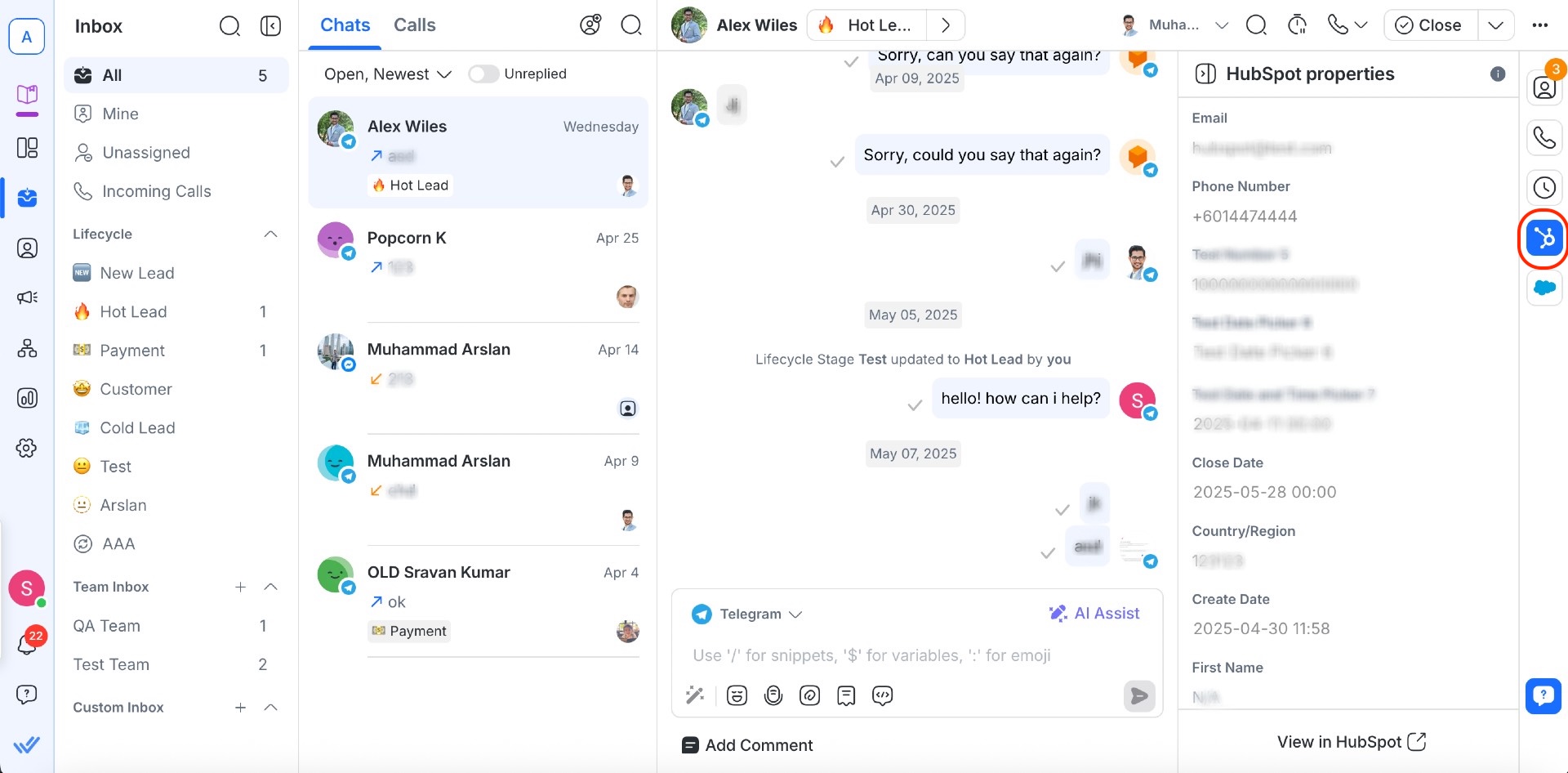
Accessing Salesforce fields:
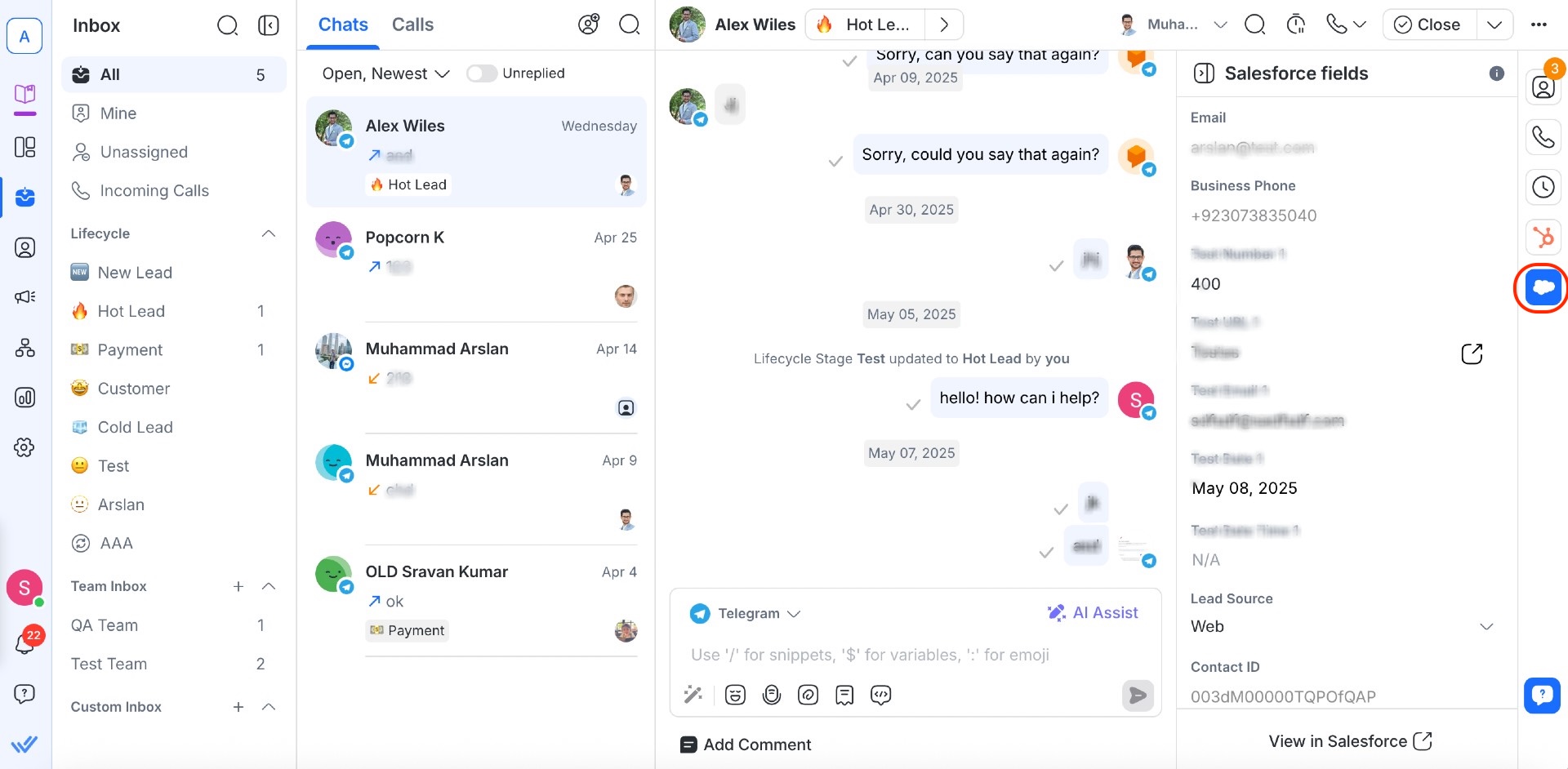
Learn more about HubSpot and Salesforce integrations.
FAQ and Troubleshooting
How do I delete sent messages?
You cannot delete sent messages because there is a limitation from Channels (Facebook, WhatsApp, Instagram, etc.); they do not allow you to delete sent messages.
How do I turn off the Dialogflow Bot?
You can turn off the Dialogflow Bot manually from the Inbox module with the Dialogflow Bot toggle at the conversation action bar for each Contact.
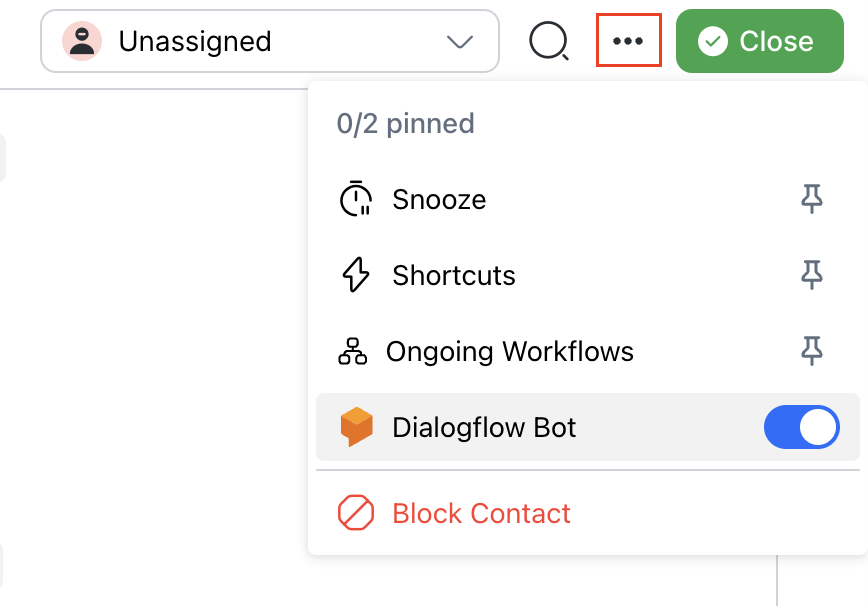
The Dialogflow Bot toggle is visible only when the Dialogflow is connected.
Choose this method to turn off your Dialogflow Bot in any of the following cases:
If you want to talk to a Contact directly
If your automated conversation is not going in the correct direction or
Your automated conversation has gone wrong
Check out the alternate ways to turn off the Dialogflow Bot from the Workflows module and by using the Bot Status Parameter.
Why is the downloaded file name different from the original?
When a file is uploaded, a random Universally Unique Identifier (UUID) is added to the beginning of its name to ensure it is unique. When you download the file, the Uniform Resource Locator (URL) is used as the file name because the file's URL domain is different from the app's domain. This results in the downloaded file name being different from the original.
Why do captions not appear with files in the conversation?
When sending a file along with a message via WhatsApp, only the file is visible in the conversation, but the associated text message does not appear.
Currently, our platform supports displaying files sent through WhatsApp, but due to limitations with WhatsApp's API, captions or text messages sent along with files are not displayed in the conversation. This is a known restriction of the WhatsApp Business API.
For more details on file messaging limitations, you can visit the Meta documentation for WhatsApp Cloud API.
For error references, see the Meta documentation on WhatsApp On-Premises errors.
Why is there a mismatch between Contact names in the conversation?
You might notice that the Contact name shown in a conversation doesn’t match the name displayed in other areas like Contact Details or the Contact Drawer. This inconsistency is often caused by browser translation plugins, such as the Google Translate plugin.
Here's what you can do:
1. Disable the Google Translate Plugin:
Click on the Google Translate plugin icon in your browser toolbar.
Turn off the translation feature for the platform or disable the plugin entirely.
2. Set Your Preferred Language on the Platform:
Go to Settings > Profile > Language
Choose your preferred language and save your changes.
If the inconsistency persists after disabling the plugin and setting your preferred language, please contact our support team for further assistance.
If you’d like additional language options on the platform, consider submitting a feature request on our Canny page.



